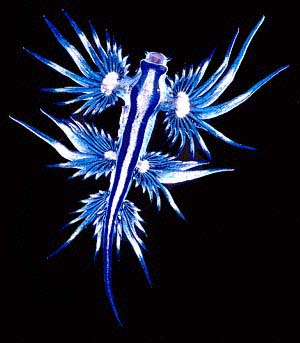
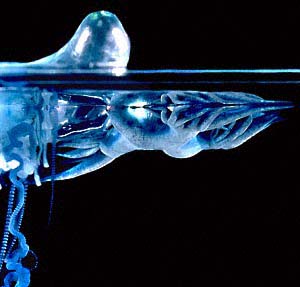
Glaucus atlanticus
Forster, 1777
Order: NUDIBRANCHIA
Suborder: AEOLIDINA
Family: Glaucidae
DISTRIBUTION
Circumglobal in temperate and tropical waters.
PHOTO
UPPER: Collaroy Beach, Sydney, February 1987. 4cm long alive. Photographed from above to show the modified foot. Note: as these animals float upside down, their foot is always dorsal. LOWER: Feeding on the "Portuguese man-of-war" or "Bluebottle", Physalia.
PHOTOS: Bill Rudman.
RELATED TOPIC
Glaucus atlanticus and its close relative, Glaucilla marginata, live in close association with what Sir Alistair Hardy described many years ago as "The Blue Fleet" - the siphonophores such as Physalia, Velella, Porpita and the other associated animals including the "Violet snails" of the genus Janthina. All these animals float on the surface of the ocean being carried by the currents and the winds. Most of us are only aware of their existence when days of onshore winds blow great fleets of them on to the beaches, causing pain and angst for swimmers.
Both species spend their life floating upside down in the water, partially bouyed by a gas bubble in their stomachs.
The two nudibranchs feed almost exclusively on Physalia, and as Tom Thompson and Isobel Bennett reported some years ago, it appears that they are able to select the most venomous of Physalia's stinging nematocysts for their own use. Like most aeolids, they store the nematocysts in special sacs (cnidosacs) at the tip of their cerata .
There are a number of reports in Australia of kids engaged in "Bluebottle" fights - where they throw stranded Physalia at each other - being badly stung by inadvertently playing with Glaucus and Glaucilla, both of which, by concentrating the most venomous of Physalia's nematocysts, are much more deadly.
Another interesting feature of the two species is their colouration. They both exhibit a textbook example of colour countershading. Their foot and undersides of the cerata, (which because they float upside down is effectively their dorsal surface), is blue or blue and white which helps to camouflage them from predation (sea birds) from above. Their true dorsal surface, which faces down in the water, is silvery grey to effectively camouflage them from fish looking up from below.
See photos of pelagic egg strings.
References:
• Bergh, L.S.R. (1884) Report on the Nudibranchiata dredged by H.M.S. Challenger during the years 1873-1876. Report of the Scientific Results of the Voyage of H.M.S. Challenger during the years 1873-76, ... Zoology, 10(26): 1-154, pls. 1-14. [Glaucus: p.10-16]
• Forster, G. (1777) A voyage round the world in His Britannic Majesty's sloop, Resolution, commanded by Capt. James Cook, during the years 1772, 3, 4, and 5 by George Forster. Vol 1: p49.
• Thompson, T.E. & McFarlane, I.D., 1967. Observations on a collection of Glaucus from the Gulf of Aden with a critical review of published records of Glaucidae (Gastropoda, Opisthobranchia). Proceedings of of the Linnean Society, 178: 10-123.
• Thompson,TE. & Bennett,I., 1969. Physalia nematocysts: Utilised by mollusks for defense. Science, 166: 1532-1533.
• Thompson,TE. & Bennett,I., 1970. Observations on Australian Glaucidae (Mollusca: Opisthobranchia). Zoological Journal of the Linnean Society, 49: 187-197.
Rudman, W.B., 1998 (November 6) Glaucus atlanticus Forster, 1777. [In] Sea Slug Forum. Australian Museum, Sydney. Available from http://www.seaslugforum.net/find/glauatla
Related messages
Glaucus from South Africa
May 3, 2010
From: Emil H Niksch
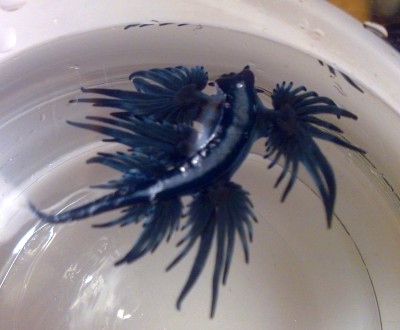
Weird Creature found on the beach in South Africa
Locality: Buffalo Bay, 0 feet, South Africa, Indian, 2 May 2010, on sandy beach at low tide. Length: 2 inches. Photographer: Emil H Niksch.
Emil H Niksch
ecoafrika@gmail.com
Niksch, E. H., 2010 (May 3) Glaucus from South Africa. [Message in] Sea Slug Forum. Australian Museum, Sydney. Available from http://www.seaslugforum.net/find/23604Dear Emil,
This is Glaucus atlanticus. There have been a number of queries about this species in the last few weeks from various parts of the world. Have a look at the species Fact Sheet, and the messages attached to it, for information on its fascinating natural history.
Best wishes,
Bill Rudman
Glaucus atlanticus from Florida
April 30, 2010
From: Stephanie Armentrout
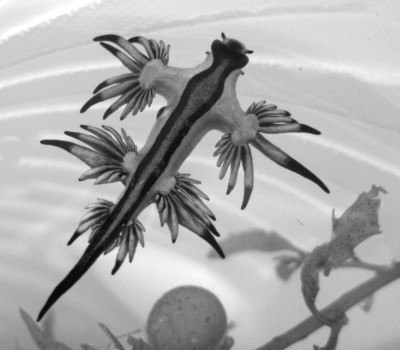
Concerning message #19205:
hey there, i'm not sure of the species, but we found a couple of the exact ones on miami beach, fl. US this past weekend. they were floating near the seaweed.
Locality: Miami beach, on shore, Florida, US, atlantic, april 24th, 2010. Length: 1". Photographer: Stephanie Armentrout.
Stephanie Armentrout
sdotdesign@gmail.com
Armentrout, S., 2010 (Apr 30) Glaucus atlanticus from Florida. [Message in] Sea Slug Forum. Australian Museum, Sydney. Available from http://www.seaslugforum.net/find/23577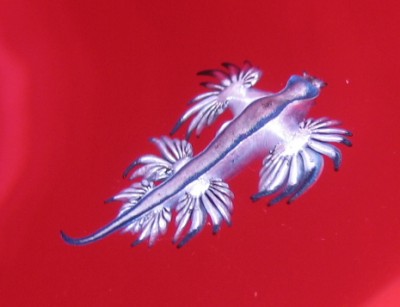
Dear Stephanie,
Yes this is Glaucus atlanticus.
Best wishes,
Bill Rudman
Glaucus atlanticus from nthn New South Wales
April 23, 2010
From: Jayson Dyer
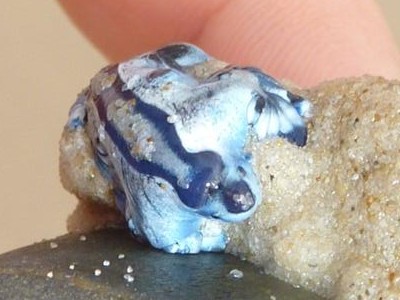
Trying to found out what this is
Locality: Byron bay, washed onshore, N.S.W, 2 feb 2010, beach. Length: 17 mm. Photographer: steff.
Jayson Dyer
kjkj666@hotmail.com
Dyer, J., 2010 (Apr 23) Glaucus atlanticus from nthn New South Wales. [Message in] Sea Slug Forum. Australian Museum, Sydney. Available from http://www.seaslugforum.net/find/23552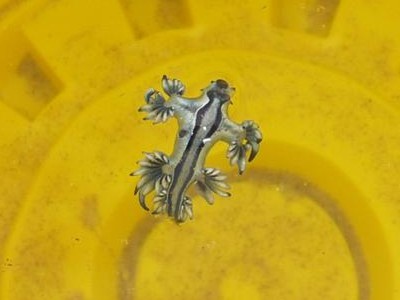
Dear Jayson,
This is the nudibranch Glaucus atlanticus. It looks much better in its normal habitat - which is floating on the surface in the open sea - where it feeds on Blue-bottles. Have a look at the species' Fact Sheet and at earlier messages attached to that Fact Sheet for more information
Best wishes,
Bill Rudman
Re: Glaucus atlanticus from Florida
April 6, 2010
From: Douglas Hernandez
Concerning message #23434:
Dear Mr. Bill we saw this Glaucus atlanticus in color white and blue on Hollywood Beach, Florida last Saturday May 3, floating on the shore.
I have a question, My son get a pain and rash like a Jellyfish burn on his leg on this day, but we saw the Glaucus later on this day and now I not sure if that rash inside my son's swimming shorts was caused by the Glaucus.
If this a poison? Because I find inside my son's underwear some little things like that (Glaucus).
Appreciate your comments
Douglas
douglas@dgsmiami.net
Hernandez, D., 2010 (Apr 6) Re: Glaucus atlanticus from Florida. [Message in] Sea Slug Forum. Australian Museum, Sydney. Available from http://www.seaslugforum.net/find/23444Dear Douglas,
I am afraid it is often difficult to identify the cause of stings at the beach. If look at the Glaucus Fact Sheet and earlier mesages attached to that page you will see that they have stinging cells which they have 'stolen' from their main food, which is Physalia [Portugese man-o-war or Bluebottle]. Often Physalia washes up on the shore at the same time as Glaucus and its long tentacles, which are lined with stinging cells, can be broken off in the waves and the broken pieces float around in the sea water, almost invisible and unnoticed, until someone gets stung.
Best wishes,
Bill Rudman
Glaucus atlanticus from Florida
April 5, 2010
From: Emma C.

Concerning message #19551:
Today me and my friends and family were at the Key Biscayne beach in Miami Florida. We saw one of those 3 and we were trying to find out what it was we got pictures and thought it was a new species. Does it relate to anything??? It was low tide. How does it get from Mexico to Miami?
Locality: Miami , 3 inches, Florida, Atlantic, 02 April 2010, Low tide , no waves very calm near seaweed. Length: 4 centimeters. Photographer: my dad.
Emma C.
salomeb@msn.com
Emma C., 2010 (Apr 5) Glaucus atlanticus from Florida. [Message in] Sea Slug Forum. Australian Museum, Sydney. Available from http://www.seaslugforum.net/find/23434Dear Emma,
Yes this is Glaucus atlanticus. If you look at the species' Fact Sheet and the other messages attached to it, you will find a lot of information on its biology. It is found in many of the world's oceans, so the ones reported from the Pacific coast of Mexico have probably been living separate lives from those in Atlantic waters for many thousands, if not millions of years.
Best wishes,
Bill Rudman
Blue Bottles and Nudibranch washed up at Kiama, NSW
March 24, 2010
From: Cherie Noon
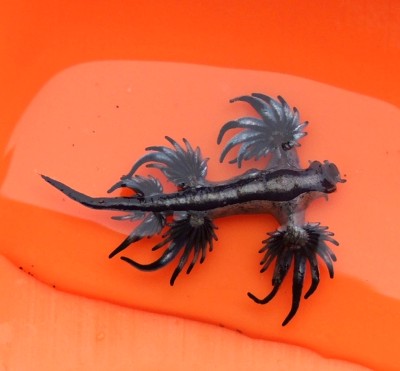
This Nudibranch was found at Kiama, East Van Park, East Beach. It was a windy and rainy day, The beach had washed up Blue bottles every where. I was showing my daughter the blue bottles and we found the Nudibranch on the sand. After taking photos we put it back into the water, hopefully it survived.
Locality: East Beach Kiama, NSW, Australia, South Pacific Ocean/Tasman Sea, Feburary 2009, Sandy Beach. Length: 30mm. Photographer: Cherie Noon.
Cherie Noon
cherienoon@bigpond.com
Noon, C.L., 2010 (Mar 24) Blue Bottles and Nudibranch washed up at Kiama, NSW. [Message in] Sea Slug Forum. Australian Museum, Sydney. Available from http://www.seaslugforum.net/find/23389Dear Cherie,
This is Glaucus atlanticus, a nudirbanch which spends its whole live floating upside down on or near the surface feeding on bluebottles. Have a look at the Fact Sheet and attached messages for more information on this species.
A slight word of warning. Glaucus takes the stinging cells out of the bluebottle and stores then in a sac at the tip of each of its long cerata. The stinging cells remain functional and you can get a more painful sting from the nudibranch than the bluebottle. I don't know if kids still have bluebottle fights at the beach, but getting hit by a flying Glaucus can end hostilities very quickly.
Best wishes,
Bill Rudman
Glaucus atlanticus in Hawaii
January 29, 2010
From: Aaron Silva
I spotted a Glaucus atlanticus on Waimanalo Beach on Oahu. It was at 9;30 a.m. January 20, 2010. I'm not sure how common they are in Hawaii, but I have lived here all my life and have never seen one before. There were also many large Portuguese Man O War on the beach.
Locality: Waimanalo Beach, On the beach. , Hawaii, U.S.A, Pacific, 20 January 2010, Wet Sand. Length: 3/4 of an inch
Aaron Silva
emunesystem@yahoo.com
Silva, A., 2010 (Jan 29) Glaucus atlanticus in Hawaii. [Message in] Sea Slug Forum. Australian Museum, Sydney. Available from http://www.seaslugforum.net/find/23136Dear Aaron,
I'm not sure how common they are in Hawaii, but they have certainly been reported from there. Often they wash up on the tide after the Portugese man o war and because they are often very mishapen, they are often mistaken for broken pieces of the Portugese man o war.
Best wishes,
Bill Rudman
Glaucus atlanticus find in Northern NSW Australia
January 20, 2010
From: Matthew Ross
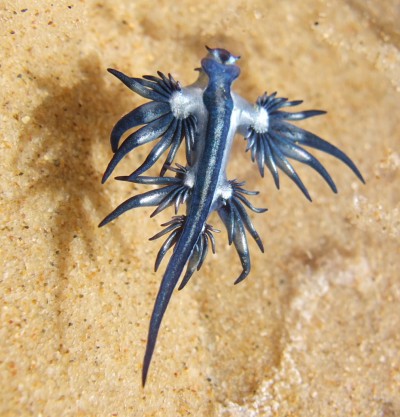
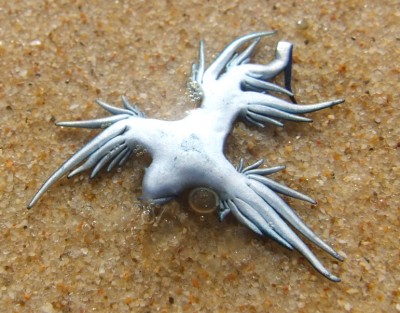
Just before Christmas last year we had onshore winds blowing all day and it was overcast. So we decided to go for a walk down the beach with the kids.
My Wife, as always, had her camera on hand and took photo's of these beautiful creatures that had washed up with the Velella Vellela, blue bottles and small jellyfish.
When we placed the Glaucus in the water upside down they would slowly flip themselves over. When they were on the sand they were compact and closed in as if trying to keep warm. It was amazing to watch them open up every time we put them in the water.
We have many more photo's if you wish to see more.
Locality: Minnie Waters main beach North end near headland. East of Grafton, on shore, NSW Australia, Pacific, 21 December 2009, sandy beach onshore winds. Length: 10mm to 20mm. Photographer: Fiona Ross.
Matthew Ross
mattyross46@hotmail.com
Ross, M.V., 2010 (Jan 20) Glaucus atlanticus find in Northern NSW Australia. [Message in] Sea Slug Forum. Australian Museum, Sydney. Available from http://www.seaslugforum.net/find/23104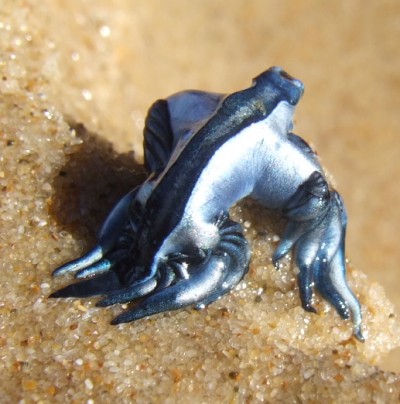
Dear Matt,
As your wife's lower photo shows these blue animals look quite tragic when they are washed up limp on the sand, but as the upper photo shows they are spectacularly beautiful web floating in their natural position. As you will read on the Fact Sheet, Glaucus is an aeolid nudibranch, and aeolids are normally found crawling along on hard surfaces. Glaucus and its close relative Glaucilla marginata, are quite different in the way they float upside down in the open ocean. In the upper photo we can see it floating upside down, its foot attached to the surface film. The second photo shows the 'back' of a washed up animal. From these two photos you can see the back of the animal is silver while the underside has dark blue stripes. As the animal floats upside down it means the siver side faces down into the water while the dark blue side faces up. A similar colour pattern is found in pelagic fish and is a way of hiding from predators - from underneath the hide from fish by merging with the silvery white of the sky, and from the sky the hide from sea birds by looking like the deep blue sea.
Best wishes,
Bill Rudman
Glaucus atlanticus from Hawaii
September 8, 2009
From: Enjoli' Hoskins
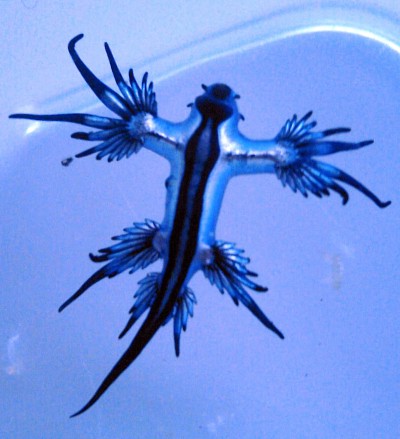
Concerning message #1814:
Hi
I live on the island of Kauai (Hawai'i) and yesterday my children and I found this beautiful creature. Intrigued we looked online to learn more about the creature and located this site. Now we know the creature as Glaucilla marginata (a remarkably beautiful sea slug).
Locality: Nukuli'i, 1-2 feet, HI, USA, Pacific Ocean, 04 September 2009, rough; choppy. Length: 1 in. Photographer: Jeff .
Enjoli' Hoskins
enjoli@hawaii.edu
Hoskins, E.K., 2009 (Sep 8) Glaucus atlanticus from Hawaii. [Message in] Sea Slug Forum. Australian Museum, Sydney. Available from http://www.seaslugforum.net/find/22654Dear Enjoli,
Your animal is Glaucus atlanticus which is a very close relative of Glaucilla marginata. The only sure way to distinguish the two species externally is that in Glaucus the finger-like cerata are arranged in a single row, while in Glaucilla they are in multiple rows.
Whatever the species, both are remarkably beautiful and live a strange and fascinating life.
Best wishes,
Bill Rudman
Occurrence of albino Glaucus atlanticus?
August 31, 2009
From: Evan Orellana
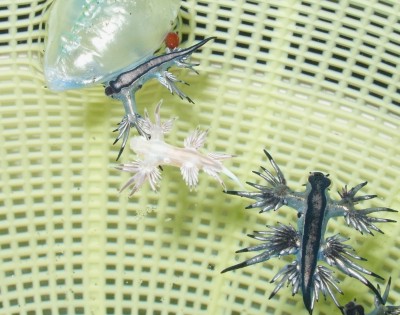
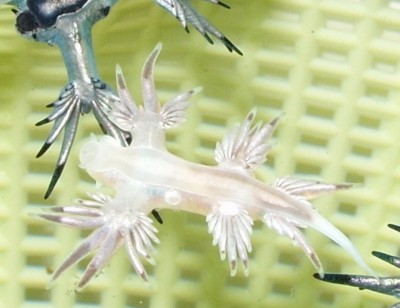
Greetings,
I work over at a nature center in southeast Florida doing research on cnidarian nematocysts. One day we collected several Glaucus from the shore and found one lacking pigment. I kept it for several weeks and got some photos. is this common? or has ever been recorded so far?
Locality: Boca Raton , 0ft. at shore, Florida, USA, Atlantic Ocean, 21 February 2009, strong ofshore winds, current northern. Length: 16 mm. Photographer: Kim Mohlenhoff.
Evan Orellana
e_orellan@hotmail.com
Orellana, E.R., 2009 (Aug 31) Occurrence of albino Glaucus atlanticus?. [Message in] Sea Slug Forum. Australian Museum, Sydney. Available from http://www.seaslugforum.net/find/22627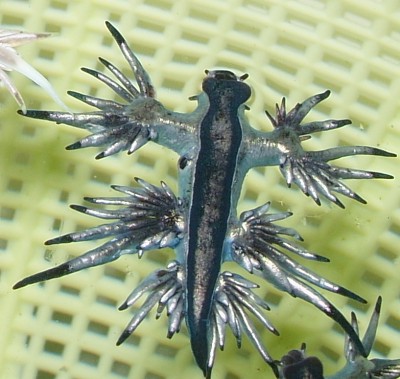
Dear Evan,
Thanks for the interesting observation. I must say I have never seen a pigmentless Glaucus atlanticus. I have checked through the little bit of literature I know of these animals and can't find any reference to albino forms like this.If anyone knows of any records they would be greatly appreciated.
Best wishes,
Bill Rudman
Glaucus atlanticus from Pacific coast of Panama
May 14, 2009
From: Clark Misner
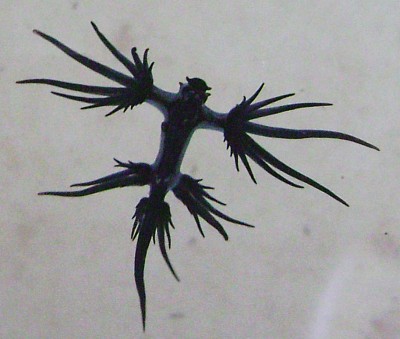
Concerning message #16534:
I found a batch of these little guys on the Pacific side of Panama. These are black though.
To me they look like live tattoos. I suppose that since they eat Man-o-wars they wouldn't be a good candidate for an aquarium.
Sorry about the quality of the photos. I never really thought I would be taking shots of such little critters.
Locality: Playa Uverito, on the beach, Panama, Pacific Ocean, 09 April 2009, Washed up on the beach. Length: 1.5 inches. Photographer: Clark Misner.
Clark Misner
clarkmisner@yahoo.com
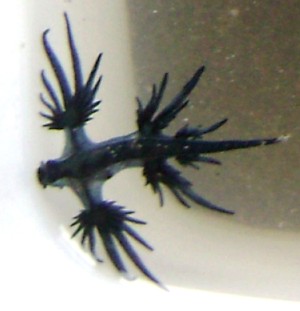
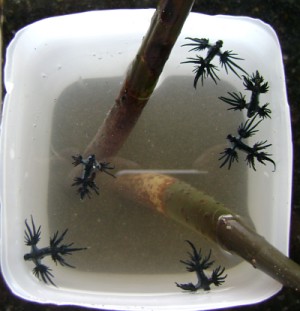

Dear Clark,
Although they looked black against the bright white of the plastic container, in enlarged views of your photos we can see that they have the classic dark and paler blue colour. As you suggest they don't make good aquariun residents, not only because of their preferred food - but because all of these animals which float around in the open ocean find the constant contact with the aquarium walls and the lack of water movement to be completely foreign to them.
Best wishes,
Bill Rudman
My Glaucus atlanticus Report
May 14, 2009
From: Kenneth Hattersley
Concerning message #22410:
Here is my school report on Glaucus.
Glaucus atlanticus, a member of the phylum Mollusca, is a magnificent creature. Sometimes the G. atlanticus is referred to as the Blue Slug, Sea Lizard, and sometimes Sea Dragon. I will relinquish my vast knowledge and explain to you the mating habits, eating habits, ways of living, defensive measures, and other random facts based on this wonderful creature. Let's begin our journey through the anatomy and life of the Sea Lizard, starting with its unique food intake.
To start off, this slug is basically anywhere the Porpita porpita (Blue Button), Velella velella (simply known as velella or the By-the-Wind-Sailor), and Physalia physalis (Portuguese Man of War) are found. The reason behind this is that the slug feeds on these specific members of Hydrozoa, but more exclusively the Physalia. These blue slugs use something called rhinophores to seek out their prey. A rhinophore is essentially a sense of "smell." The word comes from two Greek words, Rhino meaning nose, and phore meaning carrier. People use their noses to pick up scent causing chemicals in the air with receptors that send messages to be deciphered by your brain. This is the same basic idea with rhinophores. The rhinophores pick up the chemicals in the water and sensory receptors, once again, send them to be deciphered by the slug's brain giving them an alert as to which way food is. They then attempt to propel themselves in that direction, this propulsion problem I will discuss later. Once the prey is found the daring slug will latch itself to the tentacles of the feared Portuguese Man of War and go to town. Interestingly enough the slug is immune to the powerful sting, and turns it around and uses it for its own benefit and protection, once again to be explained further on. The slugs not only eats these members of the Hydrozoan family, but will in a lot of cases as a result of limited food or close quarters, eat its own kind. In a lot of cases the Sea Dragon will come across one of its own and begin to eat it head first, slug cannibalism. This cannibalism was completely unheard of until somewhat recently. The Sea Lizards accomplish the task of eating the thick, chitinous outer layer of their prey velella and their own kind with the help of their own chitinous, razor like teeth that interlock like a zipper when the slug closes its mouth. There is a single long row of razor sharp, curved, pointed teeth all of which are serrulated like the leaves of a rose or the sharp side of a bread knife which are specialized for tearing through the hard, chitinous, outer rim, called the tentaculiform papillae, of their prey.
This slug also has another crazy feature... its unique defense mechanism. This slug eats the tentacles of poisonous, deadly hydrozoans and, while doing that sorts the nematocysts and picks out the most venomous of them and uses them for their own protection. The slug stores these stolen nematocysts in the cnidosacs in the ends of their cerata, or tentacle like structures at the end of the "arms," for future use. Due to this unique defense, G. atlanticus can deliver a much more deadly, painful sting than that of a Man of War. Australian kids have a game they play with the washed ashore bodies of the Man of Wars, or so called by them Blue Bottles, where they pick them up and throw them at each other. Sounds dangerous to me but people grow accustomed to a lot of things; anyway, as they play this game they sometimes accidentally stumble across a Glaucus, pick it up and hurl it at their buddy, delivering a much more painful sting. This is due to the way these creatures choose the nematocysts. It is said that the blue color is a "tell tale" sign of "Danger! Do not touch!" Therefore the G. atlanticus is very usually left alone. As you can see, accidents sometimes happen. In the water it is not known if the slugs mistake humans for food due to smell and migrate towards people (don't know why they would), but in any case that isn't a threat due to the method of movement.
The G. atlanticus has a very interesting, yet little known about mode of transportation. This slug has an air sac on what seems to be the dorsal side. However, although it looks as though the side of the Sea Lizard you can see in the photograph above is the dorsal side, it isn't. The G. atlanticus spends its life floating along the top of the water, dorsal side down and foot up, just cruising along in search of food putting its rhinophores to use. I'm not quite sure how the Sea Lizard gets to the food its rhinophores help locate. This is the only thing about this creature that somewhat baffles me. Movement is not actually controlled by the slug itself. Although it has been seen to try, the slug is not able to control its own movement. The slug can sometimes be seen attempting to wriggle its way across the sea along the top of the water, but self propulsion for this species of slug is a fail. The Sea Lizard relies on the wind and ocean currents but either way this is a pretty interesting, slow way of movement and altogether life. The Blue Slugs entire life after the larval stage is spent upside down floating on its back buoying itself with its air sac. An interesting touch to this slug's defense is its coloration.
The foot (which faces upwards) is colored a dark blue to grey to camouflage itself from predators that attack from above such as seagull or pelicans. Its underside (dorsal on this specific creature) is a light, silvery grey to keep safe from predators from below suck as sea turtles, that also eat Man of Wars thus, are immune to the slugs powerful sting.
These creatures mating habits are also very abnormal. The Blue Slug is what is called a hermaphrodite, meaning it is both sexes in one. It has a hole on the right side of its body (when looking for dorsal side) between the two larger ceratal clumps, holding both the male and female reproductive organs. It has been said that the creature cannot, or just does not fertilize itself. The slug has an immensely long penis, sometimes longer than its body. Reason for this abnormally larger reproductive organ is to have the ability to reach past the out hanging ceratal clumps of its potential partner. The only other animal that's penis size in relation to body size that can rival that of the Sea Dragon is that of the sessile creature the barnacle. Barnacles have the largest penis in relation to body size in the entire animal kingdom. Back on topic, the female organs produce egg strings that either spiral or string out of the hole that seems to be on the left if the slug is viewed overlooking the foot. Each egg string will hold 12-20 eggs in them. The eggs in this egg string will remain attached to each other until the larvae hatch and are on their way. A lot of times, in stress, the slug will Evert its penis for no apparent reason whatsoever. In one case, a man was watching the mating process and reported seeing a larger of two Glaucus attempting to eat the others penis before mating. Now, there have never been any other reports of before mating one eating the others reproductive organ but it is said that this could be possible due to the often cannibalistic ways of the Blue Lizard. Another question also arose during my reading...is there a preference of being either male or female during mating? The answer came up soon after, with a response that stated that during mating both slugs involved will be male and female releasing both sperm and eggs in one mating session. There is also another sea slug very closely related to the G. atlanticus.
This almost identical relative of the Glaucus is known as the Glaucilla marginata. These two slugs are almost exactly alike with few key differences. To start this section off we will begin with a common factor. These two slugs both have what is called bilateral symmetry, in other words if you were to cut them in half directly down the middle it would be exactly the same on both sides. Both sides have the same amounts of cerata that are all equal in length and width. I'm not certain whether the amount of nematocysts is the same on both sides but considering the bilateral symmetry, I'd imagine they would be. The colors and designs along the dorsal and foot are also equal on both sides of the slug. Both slugs have eyes that extend from their heads and can see in all directions. Now, one of these key differences that set these two similar slugs apart is size. The Glaucus is much larger in size ranging from about 2-3 mm as a juvenile to 20-30 mm or more as an adult (*note* these creatures are found mainly in Australia, thus, the metric system is used). The smaller Glaucilla gets only to about 5-10 mm as an adult. Both of these creatures feed on the same things and have the same method of movement, but I assure you size isn't the only difference. The cerata of the G. marginata, unlike those of the G. atlanticus, are multi layered, having several overlapping rows of cerata. The cerata of the G. atlanticus have only one row of longer cerata per "arm." The locality of these creatures varies widely.
Attempts to keep these creatures in captivity with one another has turned out to be an extreme fail, resulting in death of the majority of the captive slugs due to cannibalism and the eventual death of the remaining captives due to one thing or another. The idea behind such quick death in these captive specimens is thought to be because of the fact that the slugs in captivity were found on the beaches and had been there for periods of time, and had probably been roughed up quite a bit by the waves as they came in. No matter how long they last in captivity the will always be happier in the ocean where they belong.
The locality is definitely needed to go into with more detail. As I stated previously, the Sea Lizard basically follows around its food source, the Portuguese Man of War, to all stretches of the earth. In hearing that, you can now assume that the locality of these magnificent, complex creatures is not partial to one specific region. They call any warm, sub-tropic, salt based body of water home. From the waters of Africa and South Eastern Europe, to the coasts of Australia, and even in our own backyard, right here in the Gulf of Mexico. So when you're visiting the beach over summer and those strong winds are blowing in off the coast, they are bringing more than the easily visible Man of Wars. If you spot a Man of War, be wary and take extra caution as these little floating slugs are much harder to see than the hydrozoans, due to their miniscule size.
As you can see if have taken a liking to these beautiful, awesome, complex creatures the Glaucus atlanticus, and have learned basically all there is to know about the natural marvels...from their eating habits, to their form of motion, to the way they make babies. I now have passed this information on to you.
Kenneth Hattersley
little_kenny_h@yahoo.com
Hattersley, K.P., 2009 (May 14) My Glaucus atlanticus Report. [Message in] Sea Slug Forum. Australian Museum, Sydney. Available from http://www.seaslugforum.net/find/22413Dear Kenny,
Thanks for this copy of your very comprehensive report on Glaucus atlanticus. I did not realise when you wrote earlier that you were preparing such a project. I hope your classmates - and teacher - were impressed
Best wishes,
Bill Rudman
Glaucus atlanticus in Gulf of Mexico?
April 7, 2009
From: Kenneth Hattersley
Concerning message #18991:
Bill,
I am somewhat concerned ... I tend to go to the beach quite frequently through the summer months. I live right off the Gulf of Mexico in Corpus Christi, Texas and visit the beach on a semi-daily basis. I see a lot of the hydrozoans referred to as the Portuguese man of war and am wondering does Glaucus atlanticus tends to show up in the Gulf of Mexico as well? As you probably know, I am wondering this out of concern for myself and little brothers and sisters as I am only 17. These little creatures though amazing as they are, are quite frightening considering their devastating sting.
Thanks,
Kenneth Hattersley
High School Student
little_kenny_h@yahoo.com
Hattersley, K.P., 2009 (Apr 7) Glaucus atlanticus in Gulf of Mexico?. [Message in] Sea Slug Forum. Australian Museum, Sydney. Available from http://www.seaslugforum.net/find/22410Dear Kenny,
Unfortunately Glaucus is found in the Gulf of Mexico. Since Glaucus feeds primarily on Physalia (Portuguese man of war) I guess when you see Physalia around then you should be aware that Glaucus is also likely to be present. Here in Australia the 'Portuguese man of war' is known as a 'blue-bottle' and blue-bottle stings are part of every kid's summer experience - not the best experience but unless you suffer strong allergic reactions not one to make you afraid to go to the beach. I guess what I am saying is that if after 17 years you have learnt to live with and avoid the Portuguese man of war, then you should consider Glaucus to be part of the 'Portuguese man of war threat'.
Best wishes,
Bill Rudman
Re: Tiny, elaborate creature at Stradbroke Island, Queensland
March 17, 2009
From: Paul Stewart
Concerning message #21205:
Hi Bill,
With reference to the email above I wonder if the animal is in fact Glaucilla marginata
In Glaucus the cerata are arranged in a single row in each arch while in Glaucilla there are multiple rows.
In the link below I have photographed both species for comparison.
http://www.flickr.com/photos/29056374@N04/3344062842/
Paul Stewart (flicker username paulhypnos)
hypnos1@live.com.au
Stewart, P. A., 2009 (Mar 17) Re: Tiny, elaborate creature at Stradbroke Island, Queensland. [Message in] Sea Slug Forum. Australian Museum, Sydney. Available from http://www.seaslugforum.net/find/22333Dear Paul,
It's possible the photo you refer to is Glaucilla but I can only see one row of cerata in the photo of the washed up animal. There are limits to what you can do from a single photo. I usually say 'I think' or 'I am pretty sure' when I identify such photos but as the Fact Sheets of both species link to each I am sure that if Ken wanted further information he could find it easily.
I note the last paragraph on your Flicker page is a direct copy from the Forum's Glaucilla marginata Fact Sheet.
Both Glaucus and Glaucilla appear to be "monotypic" genera. That is each genus has only one species. The main external difference is that in Glaucus the cerata are arranged in a single row in each arch while in Glaucilla there are multiple rows.
I don't mind my work being used - that's what it is there for, and I am grateful for your link to the Glaucus atlanticus Fact Sheet, but when paragraphs are just copied complete as you have here, then the original author should be cited.
Best wishes,
Bill Rudman
Glaucus atlanticus from Kenya
January 8, 2009
From: Debs North
Concerning message #11959:
I was so pleased to find this site today. When I was a very small child, living in Kenya, I found a large number of (what I now believe to be) Glaucus atlanticus washed up along the shore near Mombasa. For the last forty years I have remembered and marvelled over the sight, sometimes being told that I had imagined these wonderful little dragons. Today, I discovered, thanks to you, that it was real. Thank you so much!
Locality: Belkeith, near Mombasa, shoreline, Kenya, Indian Ocean, 1965ish, coral sand inside the reef. Length: 10 - 30 mm
Debs North
deborah.north@orange.fr
North, D.R., 2009 (Jan 8) Glaucus atlanticus from Kenya. [Message in] Sea Slug Forum. Australian Museum, Sydney. Available from http://www.seaslugforum.net/find/22118Dear Debs,
I am glad we could solve a childhood mystery for you.
Best wishes,
Bill Rudman
Tiny, elaborate creature at Stradbroke Island, Queensland
December 3, 2007
From: Ken Thomas
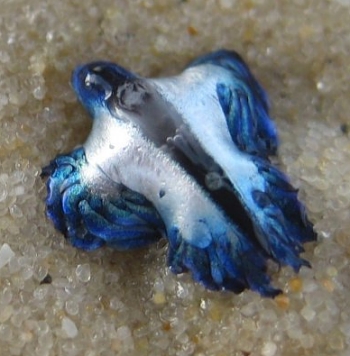
Hello,
I'd be very grateful if anyone could identify this mysterious creature, seen at Stradbroke Island on 12 November. These were scattereed along the waterline on the eastern, exposed beach which was quite rough at the time.
The photo is quite close-up, and the actual size of the animal is about 3-4 mm across.
Locality: North Stradbroke Island, --, Queenslandd, Australia, Pacific, 12 November 2007, at waterline on sand beach with strong surf. Length: 3.5 mm. Photographer: Sandi Somers.
Best regards,
Ken Thomas
ken@netgain.net.au
Thomas, K, 2007 (Dec 3) Tiny, elaborate creature at Stradbroke Island, Queensland. [Message in] Sea Slug Forum. Australian Museum, Sydney. Available from http://www.seaslugforum.net/find/21205Dear Ken,
This is Glaucus atlanticus. I'm afraid it looks a little sad when its stranded out of water like this. It spends its life floating upside down at the water surface feeding on the 'blue-bottle' Physalia. If you look at the Fact Sheet for the species by clicking on the underlined name you will find a lot more information on its fascinating biology. Have a look at earlier messages attached to that page for more information and photos
Best wishes,
Bill Rudman
Glaucus atlanticus from Pacific coast of Mexico
March 7, 2007
From: Joe Weiss
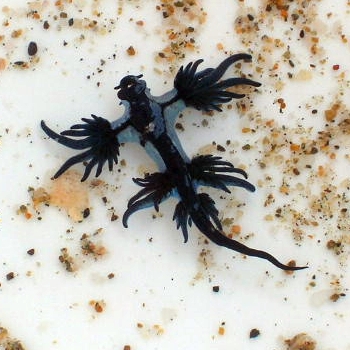
I found several of these tiny animals on a Pacific beach about 40 km north of Ixtapa, Mexico on February 23rd. Some small blue jellies washed up at the same time. The animals were only 2-3 mm in length. Brilliantly dark-blue dorsal side with silver underneath. Are they developing juveniles? I would appreciate any help in identifying them.
Locality: Troncones Beach, washed up on beach, Mexico, Pacific, 23 February, 2007, sandy beach. Length: 2-3 mm. Photographer: Angelina Gregorio.
Joe Weiss
weiss_joe@msn.com
Weiss, J.M., 2007 (Mar 7) Glaucus atlanticus from Pacific coast of Mexico. [Message in] Sea Slug Forum. Australian Museum, Sydney. Available from http://www.seaslugforum.net/find/19551Dear Joe,
This is Glaucus atlanticus, a strange, but beautiful aeolid nudibranch which spends its life floating on the open sea, feeding on Physalia and some other blue relatives of jelly fish. You mention the 'brilliantly dark-blue dorsal side'. The dark blue may look to be the dorsal side but these animals spend their lives floating upside down, so the dark blue side is actually their foot. Have a look at the Fact Sheet and attached messages on this species for more information. From its size, your animal is definitely juvenile. Unfortunately, if they are too close to shore, onshore winds can blue them in to shallow water where they become stranded and die.
Best wishes,
Bill Rudman
Sea Lizard [Glaucus atlanticus] from New South Wales
March 2, 2007
From: Lynne T.
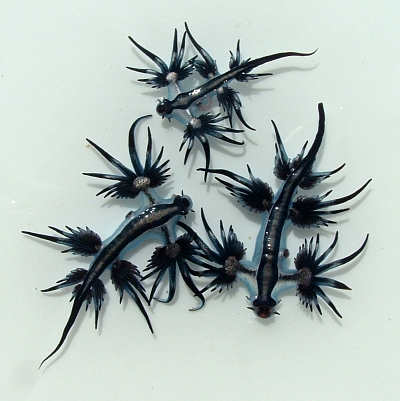
Just like to say what a great forum!!
I have been fascinated with "the blue tide" animals for many years. I recently held a few Glaucus atlanticus to take some photos. Could you tell me what the circle opening is on their left hand side and what body part comes out and goes back in? I have included a photo and the Glaucus at the top has the protruding part????
Locality: Coalcliff Beach, shore, New South Wales, Australia, Pacific Ocean, 27 Feburary 2007, washed up. Length: 30 mm. Photographer: Lynne the lifeguard!.
Lynne
ctuck@netspace.net.au
Lynne T, 2007 (Mar 2) Sea Lizard [Glaucus atlanticus] from New South Wales. [Message in] Sea Slug Forum. Australian Museum, Sydney. Available from http://www.seaslugforum.net/find/19561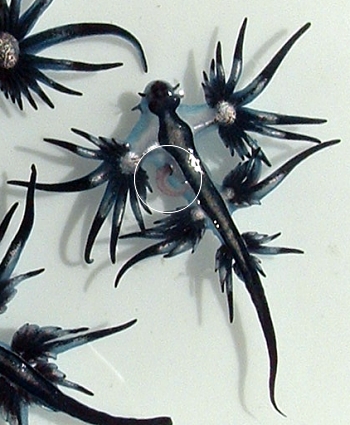
Dear Lynne,
The dark blue circle which looks like it is on the left side of their bodies, is really on their right sides, because they spend their lives floating upside down. The dark bit down the middle of their bodies is their foot, not their back. The blue circle you are interested in is the opening of their reproductive organs. Because all sea slugs are hermaphrodites with fully functional male and female organs, this opening has three functions. It has an opening to receive a partner's sperm, an opening to release its fertilised eggs, and it has a sac which contains its penis, which can be everted during mating. It is the body part you are wondering about - and they sometimes evert it just when they are stressed.
Have a look at an earlier message [#8233] for a photo of the penis, and photos of its egg string [#867 ].
Best wishes,
Bill Rudman
Glaucus atlanticus mating habits
January 29, 2007
From: Johanna Schwartz
Great site! Very informative.
I am currently doing some research for a documentary film and was wondering where I could find more information on the mating habits of these blue ocean slugs.
Am I right in thinking that even though they posses both male and female organs, they are unable to fertilise their own eggs? They have to mate with each other in order to reproduce, correct?
I have seen footage of two slugs balled up with their penis' out. The commentary talked about the slugs trying to bite each other's penis off. I haven't seen anything about this on your site though. I'd like to know more.
Which leads me to one further thought: do they prefer to do the fertilising rather than be fertilised, i.e. be male instead of female?
Many thanks!
Johanna Schwartz
johanna_schwartz@hotmail.com
Johanna Schwartz, 2007 (Jan 29) Glaucus atlanticus mating habits. [Message in] Sea Slug Forum. Australian Museum, Sydney. Available from http://www.seaslugforum.net/find/19328Dear Johanna,
As you'll see from some of the observations in the accompanying messages, Glaucus has a reputation for taking a cannibalistic bite every now and then, but I don't know of any research to show that it makes a special point of eating a potential partners' penis. See my comment to message #8233, for a photo of the penis. All nudibranchs are hermaphrodite, and yes they don't appear to self-fertilise their eggs.
Concerning a preference for being male or female. In nudibranchs, the male and female genitalia are situated together, so mating is usually reciprocal, both partners acting as male and female simultaneously. In related sea slugs, such as the Sea Hares, the penis is at the front of the body while the female opening is quite a distance back, so in a mating pair one acts as male and the other female. However if you look at the Mating Chains Fact Sheet you will see that sea hares often mate in large group chains, so most also act as both male and female at the same time.
Best wishes,
Bill Rudman
Glaucus atlanticus in Hawaii
January 16, 2007
From: Nichol Miura
We didn't know what it was until we came home and did some research online. Unfortunately, we don't have a picture at this time. We also found a juvenile Portuguese Man-O-War [Physalia] and a Purple Bubble Raft Snail [Janthina ] (though we didn't know until we saw all of the other photos). Thanks for having such a wonderful site.
We had a question. We read that it "can severely sting humans", could you elaborate on that? Thanks again for all of the great information.
Locality: Oahu, near Mokoli'i Island (21* 30'43.00" N, 157* 50'09.00" W), floating with tide, Hawaii, USA, Pacific Ocean, 14 January 2007, Clear warm waters. Length: 1 inch by 1 inch
Nichol Miura
nmiura13@hotmail.com
Miura, N., 2007 (Jan 16) Glaucus atlanticus in Hawaii. [Message in] Sea Slug Forum. Australian Museum, Sydney. Available from http://www.seaslugforum.net/find/19235Dear Nichol,
Glaucus is a very specialised aeolid nudibranch which spends its life floating upside down in the ocean. If you look at a 'normal' aeolid like Austraeolis ornata , which crawls over rocks, you will see that it has a back covered in tubular processes we call cerata. If you look at the cerata Fact Sheet you will see that at the tip of each ceras is a special sac called the cnidosac where they store stinging cells they get from their food, which is usually a sea anemone or related cnidarian. The aeolid is able to re-use these stinging cells in its own defence. Glaucus does the same, but it has found a method of accumulating the most powerful stings from the Portuguese Man-O-War. I don't know if Hawaiian kids do silly things like throwing Portuguese Man-O-War at each other for fun - but Australian kids do - and a hit from a Glaucus can be much more painful then a hit from a Portuguese Man-O-War - or 'Bluebottle' as they are called down here.
Best wishes,
Bill Rudman
What type of Nudibranch is this?
January 15, 2007
From: Adrian Giles
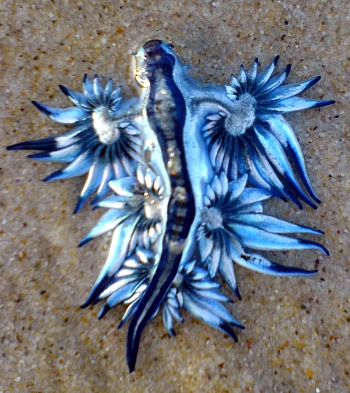
What type of nudibranch is this?
I have attached photos of some, what I believe to be nudibranchs, that washed up all along Seven Mile beach Lennox Head/Broken Head, Northern New South Wales
Locality: Seven Mile Beach, NSW, Australia, 10 January 2007
Adrian Giles
adrian.giles@dimensiondata.com.au
Giles, A., 2007 (Jan 15) What type of Nudibranch is this? . [Message in] Sea Slug Forum. Australian Museum, Sydney. Available from http://www.seaslugforum.net/find/19205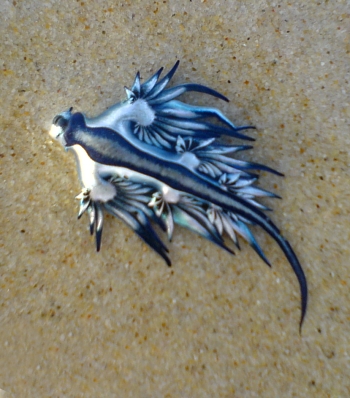
Dear Adrian,
This is Glaucus atlanticus. This strange and beautiful nudibranch spends its whole life floating upside down in the ocean, feeding on Bluebottles. Have a look at the species' Fact Sheet and associated messages for further information on the strange life of this animal.
Best wishes,
Bill Rudman
Re: Glaucus atlanticus on Gold Coast, Queensland
January 15, 2007
From: Rob Alesbury
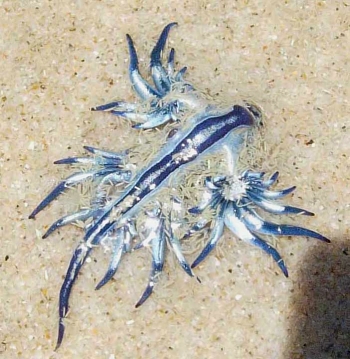
Concerning message #18991:
I counted about 30 of these creatures washed up on a small area of beach at Byron Bay, NSW, Australia on 14 December 2006. I have been trying to identify him since I returned from holiday. Are they unusual in this area?
Locality: Byron Bay, NSW, Australia, Pacific, 14 December 2006, Sandy Ocean Beach. Length: 15mm. Photographer: Rob Alesbury.
Rob Alesbury
robbiealesbury@hotmail.com
Alesbury, R., 2007 (Jan 15) Re: Glaucus atlanticus on Gold Coast, Queensland. [Message in] Sea Slug Forum. Australian Museum, Sydney. Available from http://www.seaslugforum.net/find/19223Dear Rob,
As you'll see from the Fact Sheet and associated messages, Glaucus atlanticus is usually found washed up on beaches at the same time, or perhaps a day after, bluebottles [Physalia] start to wash ashore. They belong to a group of animals which float around on the sea surface far from shore, so it normally takes a few days of onshore winds to bring them ashore.
Best wishes,
Bill Rudman
Glaucus atlanticus on Gold Coast, Queensland
December 14, 2006
From: John Campbell
Concerning message #16552:
On patrol with many long serving members and meeting older beach goers today no one had seen these little fellas [Glaucus atlanticus ] before. People were very curious and unsure of the stinging power of them as they carry that tell tale blue colour "dont touch". Are they here to stay? Or have they fallen off an Indonesian fishing boat? I read the notice of a Fraser Island sighting and am sure they are new to the region. They would be a much welcome relief from the blue bottles that arrive every summer with the northerly winds, but the number of them is a little disconcerting none the less.
Locality: North Burleigh Beach, Gold Coast, on Beach, sthn Queensland, Australia, Pacific Ocean, 10 December 2006, Sandy Ocean Beach . Length: 10 - 20 mm
John Campbell
j.campbell@burnsdesign.com.au
Campbell, J., 2006 (Dec 14) Glaucus atlanticus on Gold Coast, Queensland. [Message in] Sea Slug Forum. Australian Museum, Sydney. Available from http://www.seaslugforum.net/find/18991Dear JC,
I guess you have had a look at the Glaucus atlanticus and Bluebottle [Physalia] Fact Sheets. They are both part of a 'blue fleet' of animals living in the open ocean. Normally where you find one you will find the other, but often when there is a big invasion of bluebottles, the Glaucus are ignored or thought to be broken off bits of a Bluebottle. Don't be lulled into a false sense of security however, because the Glaucus eat bluebottles and stores the worst of the bluebottle stings at the tips of the fan-like processes we call cerata. So far from a welcome relief I must warn you that you can get a much more concentrated and powerful sting from the Glaucus than from the Bluebottles.
Best wishes,
Bill Rudman
Glaucus eating Porpita in Hawaii
August 17, 2006
From: Anna-Christina Amason
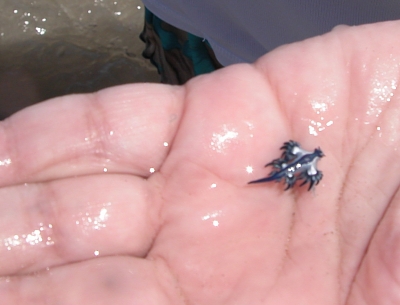
My mom and I found it (actually, it found us) in the waves at Hapuna beach (on the Kohala coast) last Wednesday, alive and well, and returned it as soon as we photographed it. It was the most amazing creature, very silver and blue. At first we thought it was someone's small plastic toy, but quickly realized it was a real creature. There were quite a few Porpita porpita, all different sizes, out that day and we also saw a tiny Man Of War float, nothing else was left.
Locality: Hapuna Beach, Hawaii, 1 meter, Hawaii, USA, Pacific, 8 August 2006, beautiful, clear water. Length: 1 cm. Photographer: Anna-Christina Amason .
I thought you might want to know, not many people have reported seeing them in the Hawaiian islands, especially Hawaii.
Anna-Christina Amason (11)
susan@tibcomm.com
Amason, A., 2006 (Aug 17) Glaucus eating Porpita in Hawaii . [Message in] Sea Slug Forum. Australian Museum, Sydney. Available from http://www.seaslugforum.net/find/17476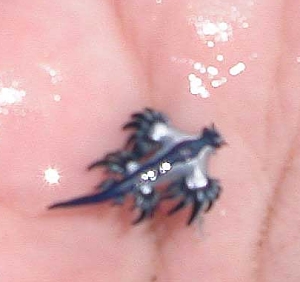
Dear Anna-Christina,
Thanks for this record of Glaucus.
Best wishes,
Bill Rudman
Feeding and some trophic interactions of Glaucus atlanticus
August 2, 2006
From: Irina Roginskaya
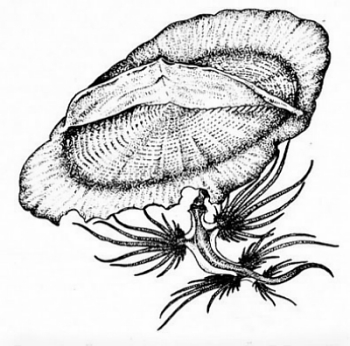
Dear Bill,
I want to add to my previous messages (Roginskaya, 2006, 2006a) some more field observations of Dr.A.I.Savilov (1956,1971), concerning the feeding behaviour of Glaucus atlanticus. And to show two pictures from the set of my recent SEM photos of details of buccal apparatus of early juveniles of Glaucus from the material , collected by A.I. Savilov in 1961 in Tropical Western Pacific.
A.I. Savilov writes: " The hungry Glaucus, holding on to Velella by the ends of tentaculiform papillae, starts to tear off and engulf the rather big pieces of the floating disc of the siphonophore . Sometimes Glaucus, bending its body, captures the edge of the disc, gnawing a whole section of the colony of polyps". (see Upper right drawing: - Glaucus eating Velella - the original illustration of A.I.Savilov in Priroda ).
The buccal armature of Glaucus includes stout chitinous jaws with rather well developed long serrulated chitinous masticatory borders with a single row of multiple curved pointed denticles (fairly even in size) along the cutting edge.(I counted more than 45 denticles on the masticatory process of a juvenile Glaucus 1.5 mm long in spirit).[see Photo B: SEM photo , x600]. When the mouth of Glaucus is closed, and the odontophore is retracted, the matched rows of denticles along the cutting edge, create a strong construction, which reminds me of a real zip fastener [see Photo C: SEM photo of the part of "zipper". x2000 of the juvenile Glaucus 1.2 mm long in spirit].
Locality: Open Ocean, surface of water, Tropical Western Pacific, 18 September 1961, pleuston. Length: 1.2 -1.5 mm. Photographer: Irina Roginskay, Viktor Karlov.
Both specimens are from the material of A.I.Savilov, collected during the cruise no.34 of R/V "Vityaz" in the Tropical Western Pacific; Sta.5086 (3 2'N, 140 8'W), 18.Sept.1961). May be these denticles help juvenile Glaucus to grasp portions of the prey and keep attached in mobile surroundings. The worn and even completely broken denticles I discovered on the masticatory borders of some minute juveniles of Glaucus, suggests that the process of feeding sometimes demands considerable efforts by juveniles and that the denticles on the cutting edge have an important role in the primary feeding.
There are very contradictory opinions by different authors concerning the predator prey interactions betweem Glaucus and Janthina. Perhaps the perfectly equipped buccal mechanism permits specimens of Glaucus from South Africa to attack and feed on the pelagic shelled gastropods Janthina. Barnard (1927) indicates Janthina as the main food item of his specimens of Glaucus. Though this seems rather unusual and puzzling for a cnidarian-feeding nudibranchs. A.I.Savilov (1971) stated on the contrary that Janthina janthina, collected during the cruise of R/V "Akademic Kurchatov" in the region of the Peru Current and kept in the aquarium with juvenile Glaucus from the same catch, successfully attacked them. Savilov even suggested that the almost complete absence in September 1968 of juveniles of Glaucus in the middle parts of Peru current, where the mass development of the population of J. janthina had been observed, could be linked not only with advancement along the Peru Current of different generations of Glaucus, but with the eating of juvenile Glaucus by Janthina.
In the observations by R. Bieri (1966) Janthina were absolutely indifferent to Glaucus: " Several times I placed active Glaucus close to Janthina prolongata, but they were never attacked and never elicited the feeding response in Janthina."
I came across another quite amazing statement of R. Buchsbaum and L.I. Milne (1962): "In warmer seas far from land the deep-violet blue nudibranch Glaucus eucharis creeps along on the underside of the surface film scavenging for minute plants and animals". Perhaps the authors mean that Glaucus eats the sutface-dwelling larval stages of Velella - Rataria?
-
Barnard K.H. 1927. South African Nudibranch Mollusca with description of new species and a note on some specimens from Tristan d'Acunha. Annals of the South African Museum, vol.XXV, no.1, pp171-215, pls.19-20.
-
Bieri R. 1966. Feeding preferences and rates of the snail Janthina prolongata, the barnacle Lepas anserifera, the nudibranch Glaucus atlanticus and Fiona pinnata and the food web in the marine pleiston. Publications Seto Marine Biological Laboratory, vol.XIV, no.2,pp.161-170, Plates III-IV.
-
Buchsbaum R. and L.J. Milne.1962. The Lower Animals.Living Invertebrates of the World. 303 pp. Published by Doubleday and Co.,Inc. Gordon City, New York.Third printing.
-
Roginskaya I.S. 2006.(May 9). Some notes about Glaucus atlanticus.[Message in] Sea Slug Forum.Australian Museum, Sydney. Available from http://www.seaslugforum.net/find/16534
-
Roginskaya I.S. 2006a. (May 25). About egg masses of Glaucus atlanticus. [Message in] Sea Slug Forum. Australian Museum, Sydney. Available from http://www.seaslugforum.net/find/ 16663.
-
Savilov A.I. 1956. Floating biocoenosis in the Pacific Ocean based on the material of the Expeditions of the Institute of Oceanology, Academy of Sciences USSR. Priroda, vol.45, no.3, pp.62-68.
-
Savilov A.I. 1971. Pattern of Pleuuston Distribution in the Region of the Peru Current. The Academy of Sciences of the USSR. Transaction of the P.P.Shirshov Institute of Oceanology. vol.89. Oceanologic Investigation in the Peru Current Area, pp.60-76.
irina7@hotmail.com
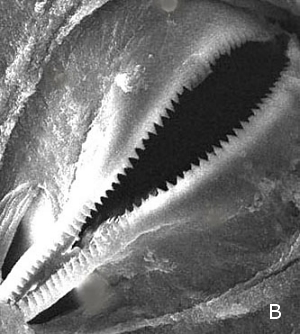
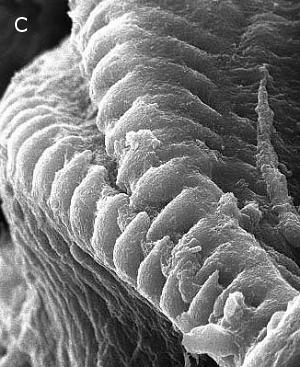
Thanks Irina,
Bill Rudman
About egg masses of Glaucus atlanticus
May 25, 2006
From: Irina Roginskaya
Concerning message #16534:
Dear Bill,
I couldn't find information from reliable sources about the coiled form of the egg masses of Glaucus atlanticus - except this one. The only mention about spiral spawns deposited by Glaucus I found in the Russian Monograph Life of Animals,1968 (in Russian). The authors of the Part "Mollusca" in this book - two well known Russian malacologists (not "branchers") B.V. Vlastov and P.V.Matyokin, on pp.65-66, discussing the morphological differences enabling Glaucus to live at the surface layers of the sea, also touch upon the egg-laying of this slug.
" This slug deposits eggs in the form of spiral ribbon, sticking it to the bell of Velella, after eating the polyps of the Velella ". [my translation].
Most authors are of opinion that the eggs of Glaucus are deposited as short, straght lines. W. Macnae (1954, p.48} even emphasizes the fact that the egg masses are not coiled.
" From the lumen of the oviduct in the region of the albumen gland several short strings of eggs were removed. Similar short, uncoiled strings about 2cm long were laid by specimens kept under observation in finger-bowls. This method of egg-laying , which is so different from other Eolids, may account for the fact that the albumen gland is neither so voluminous, nor so thick walled as in other members of the order. Each of the strings contains about 12 to 20 eggs in a single series"
The egg-strings protruded from the oviduct of one specimen of Glaucus atlanticus from the Pacific Ocean in my catch (Roginskaya, 2006) were also in the form of short straight lines. The pictures of straight short egg-strings or its fragments were displayed in many publications (e.g. R. Bergh, 1864; A. Bebbington,1986; W.B.Rudman,1999; etc.). Maybe the unusual method of depositing eggs was evolved by Glaucus because of the difficulty of building regular spirals in mobile surroundings - the oceanic surface layers, subjected to the influence of winds and currents, where the main problem is the difficulty of keeping close to Chondrophora and quickly attaching eggs to the floating object.
-
Bebbington, A. 1986. Observations on a collection of Glaucus atlanticus Gastropoda, Opisthobranchia). Haliotis, vol.15, pp.73-81.
-
Bergh,Rud. 1864. Anatomiske Bidrag til Kundscab om Aeolidierne. Kongelige Danske Videnskabernes Selskabs Skrifter, 5te Raekke, 7 te Band. 175 pp.
-
Macnae, W. 1954. On some Eolidacean Nudibranchiate Molluscs from Southern Africa. Annals Natal Museum, vol.13, part.1,pp.1-50.
-
Roginskaya, I.S. 2006.(May, 9) Some notes about Glaucus atlanticus. [Message in] Sea Slug Forum.Australian Museum, Sydney. Available from http://www.seaslugforum.net/find/16534
-
Rudman,W.B.1999 (May 16) Comment on eggs of Glaucus and Glaucilla by Bill Rudman. [Message in] Sea Slug Forum. Australian Museum, Sydney. Available from http://www.seaslugforum,net/find/867
-
Vlastov B.V. and Matyokin ,P.V. 1968. Order Acoela pp 62-67. In ; Life of Animals, vol.2. Invertebrates [Ed. L.A.Zenkevich.] Publishing House "Prosveschhenie".Moscow.
Irina Roginskaya
irina7@hotmail.com
Roginskaya I.S., 2006 (May 25) About egg masses of Glaucus atlanticus. [Message in] Sea Slug Forum. Australian Museum, Sydney. Available from http://www.seaslugforum.net/find/16663Dear Irina,
This suggestion that Glaucus can either lay a spiral egg mass or a straight string of free floating eggs is quite puzzling. Is there a drawing of the spiral egg ribbon in one of the Russian works you could send me a copy of? The straight string I am familiar with is cylindrical in shape and quite rigid. It seems to me it would need to be made differently to be deposited in a spiral.
It is certainly something that needs further investigation. Thanks for drawing our attention to it.
Best wishes,
Bill Rudman
Unknown creature from Fraser Island, Queensland
May 9, 2006
From: Richard Wilsher
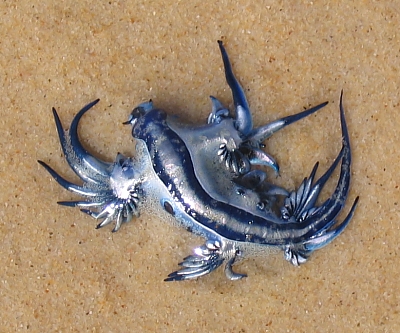
I would be grateful for any identification of the attached creature. I am a lay-person in this field but my lay-interest suggests this may be a free-swimming sea slug. An expert opinion would be much appreciated.
Locality: Fraser Island, eastern (ocean) shore, beach, QLD, AU, Pacific, 25 April 2006, washed ashore, numerous (one approx every 5 m). Length: 20 - 30 mm (specimens varied). Photographer: Richard Wilsher
Note - since your site is presumably of international significance I recommend use of the international date format as defined in ISO 8601, ccyy-mm-dd. This is used significantly and increasingly within scientific and industrial sectors
Many thanks,
RGW.
RichardG@Wilsher.net
Wilsher, R. G., 2006 (May 9) Unknown creature from Fraser Island, Queensland. [Message in] Sea Slug Forum. Australian Museum, Sydney. Available from http://www.seaslugforum.net/find/16552Dear Richard,
This is indeed an 'oceanic' nudibranch, but as you will see from Irina Roginskaya's message [#16534] she has raised the question of just how we should categorise its lifestyle - is it free swimming, free-floating, pelagic, or planktonic? I guess it depends on how important we consider its attempts at locomotion. I should mention it is a specialised aeolid, Glaucus atlanticus. If you look at the Fact Sheet, and the other relevant messages attached below, you should find plenty of information on the species.
Concerning your comment about the date. The Forum now receives approximately 250,000 visits a month from over 130 countries, so yes I think the site is of international significance. Your message from Australia and Irina's from Russia on the same subject illustrates the point quite well.
Concerning standardisation of date citation. I am all in favour of standardising dates, but while computers can be easily trained to 'know' how to interpret a set of numbers in a certain order, I am afraid people can't or won't. Until the proud - I won't say insular - citizens of the USA accept metrication, and get their day and month in the right order, any attempt at having an international standard for dates and measures won't work. So my aim is to have a standard date citation that can be understood worldwide. That is why I ask for the month to be a word not a number. Then at least if the day/month order is wrong the date is still intelligible. Most people put the year at the end of any date citation so that's what I ask. I quite understand that computer programs prefer the year first so they can sort data by year, but people don't need that facility. I can certainly interpret your suggested ISO standard 2006-04-25 as 25 April 2006, but what about 2006-04-03? I am afraid it will be interpreted by some of the world as 4 March 2006 and some as 3 April 2006. I suppose we could all have a fridge magnet with a list of ISO standards but I am afraid on my fridge it would be lost amongst the ones telling me which garbage bin goes out on Wednesday, the ones with phone numbers for emergency trademen, some funny political ones, etc.
I should say thank you to all of you who are putting the date information in the manner I have asked. It makes it easier for me and prevents confusion.
Best wishes,
Bill Rudman
Some notes about Glaucus atlanticus
May 9, 2006
From: Irina Roginskaya
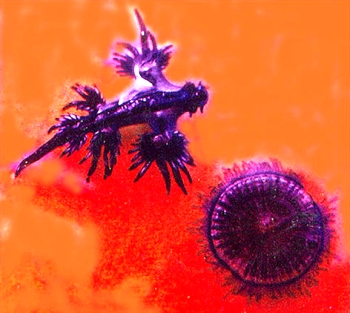
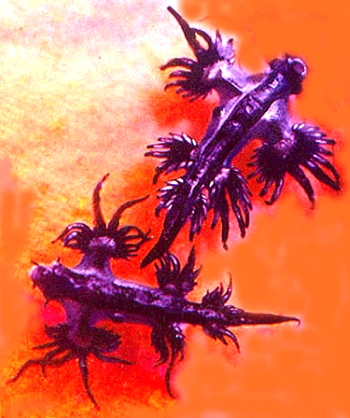
Dear Bill,
I am so glad the Forum is back! We really felt orphaned without daily opisthobranch news from all the world!
I am sending you two photographs of Glaucus atlanticus I took (as you can see from their quality) in predigital epoch) (Zenith-E camera). Three specimens of G. atlanticus were collected by pleuston net during the cruise no.59 of R/V "Vytiaz" in the Pacific Ocean.(Sta.7505, 34 17'9 N, 143 52'0 E, June 25 1976) together with their food objects hydrozoan cnidarians, the Chondrophorina: Velella with a keel-like "sail" elevated above the surface of water and disk-shaped Porpita ( the latter on photo 1) . The body length of the Glaucus in spirit 12.0 mm, 13.5 mm (dissected) and 16.5 mm. Diameter in spirit ot the disk of Porpita = 10 mm. The radula of dissected specimen contained 14 rows of teeth. This specimen was in the process of egg-laying , as the bead -like egg-strings were appearing from the oviduct. It seems to me that there were no photos in the Forum of G. atlanticus from this area.
Locality: 34 17' 9 N, 143 52' 0 E, surface of water, Open Ocean, Pacific Ocean, 25 June 1976, collected by pleuston net. Length: 12.0 mm, 13.5 mm, 16.5 mm in spirit. Photographer: IrinaS.Roginskaya
As recently a lot of messages, touching upon the feeding, egg-laying, cannibalistic habits etc. of Glaucus appeared in the Forum I couldn't resist the temptation to add some information concerning Glaucus, mainly from the observations of the late Dr. A.I.Savilov from the P.P.Shirshov Institute of Oceanology , Moscow, Russia (Savilov, 1956,1968). Perhaps these works are unknown to you and colleagues as being published in Russian only.
Dr.A.I. Savilov (1913-1969) - marine biologist, the well known specialist of the surface fauna of the ocean, keen observer, amateur graphic artist, participant of many scientific ocean cruises. You can find in his papers a lot of life history characteristics of bouyant organisms: Glaucus, Glaucilla, Fiona, Janthina, Physalia, Velella, Porpita, Actiniaria etc. The fragments of text I cite here are from two papers of A.I. Savilov [my translation - so please be understanding] .
From Savilov,1956, page 65:
"Glaucus is a carnivore, feeding on Velella. It prefers to keep freely on the surface of water and approaches the prey only being hungry. For long hours during the drift of "Vytiaz' we looked closely from the board at the surface of the ocean in hope to reveal Glaucus in the middle of floating past Velellas. At last we were lucky to discover it. In the slightly splashing water we noticed an exemplar of swimming Velella and behind it broadly spreading their papillae the pair of Glaucus keeping on the surface. The velvety-blue coloured molluscs were nearly invisible on the background of the blue-green ocean depth. Sometimes when the Glaucus were thrown away by wave or a splash of water, they rather quickly, paddling with the bundles of papillae as with oars, rowed back to Velella."
This contrary to the opinion of T.E.Thompson and I.D.MacFarlane (1967) that "small contractions and movements of the cerata and metapodium are not directional in function. Glaucus is thus planktonic rather than pelagic" and later of T.E.Thompson (1976), considering glaucid nudibranchs to be passively planktonic as the movements of their cerata "do not appear to result in translocation". P. Bieri was aware of these field observations of Savilov (1956), concerning the intentional swimming of free-living Glaucus atlanticus to its prey. (Mr. Saburo Nishimura kindly lent him his translation of Savilov's report). But R. Bieri stated that the specimens of Glaucus in his experiments - maintained in jars with running water - could not swim. I think that as these laboratory observations may not reflect the conditions in the open sea, the behaviour of his Glaucus could be greatly affected by maintenance in captivity. By the way, A. Fredol characterizing Glaucus wrote: "Quoique paresseux, il nage avec vitesse". If the observations of Savilov (1956) are not accidental we can consider Glaucus to be a pelagic organism rather than a planktonic one.
P. Bieri (1966) already described the cannibalistic habits of his specimens of Glaucus:
" Glaucus frequently attacked one another and bit off pieces of tail and 'arms". One 20 mm long individual ate all but the head and trunk of a 15 mm long individual in 30 minutes." And further in the Discussion: "Glaucus prefers Physalia. On the other hand, when food is in short supply or after periods of prolonged starvation, the niche differentiation probably breaks down and then even cannibalism is practiced by Janthina and Glaucus. (The same situation as described by Peter Whiter (Whiter, P. 2006 .March 28) and earlier by R. Armstrong (Armstrong, R.1999. Feb.26).
A.I. Savilov (1968) describes the egg-laying of Glaucus.:
" For egg-laying, Glaucus needs floating objects. They attach their egg-masses to the skeleton plates of dead Chondrophora and small driftwood". He also emphasizes the importance of Chondrophora as distributional and topical factor (page 292). " The skeletal plates of Chondrophora after being picked clean by predators, retain their bouyancy for a long time and are frequently used for attachment of egg masses. Some species (Glaucus, Halobates) utilize these plates for laying their cocoons and eggs, the others - for attachment of their juveniles during the first days of their life (Lepas ), until their own floats are produced; some species inhabit skeleton plates either permanently (Fiona, Turbellaria) or temporary (Planes, Isothea, Metapennaeus)".
There is similar data about the egg-laying of Glaucus in the monograph of W.J. Dakin (1953). He indicated (pages 270-271) that " Requiring something a little more substantial than water on which to deposit its egg masses , Glaucus feeds on Velella, lays its eggs on the skeleton framework of the creature it has been eating". Maybe only in the absence of suitable substrata are specimens of Glaucus forced to deposit their egg-strings directly on the surface where they float. (Rudman,1999. Feb 25). Thompson and MacFarlane (1967) admit both modes of egg-laying: " Strings of eggs each consisting of 12 to 15 eggs are shed into the sea, or attached to the prey".
-
Armstrong, R.1999 (Feb.26) Re: Glaucus in New Zealand. Message in Sea Slug Forum. Australian Museum,Sydney. Available from http://www.seaslugforum.net/find/616
-
Bieri R. 1966. Feeding preferences and rates of the snail, Janthina prolongata, the barnacle Lepas anserifera, the nudibranchs Glaucus atlanticus and Fiona pinnata and the food web in the marine pleiston. Publications Seto Marine Biological Laboratory, vol.XIV, no.2, pp.161-170, PlatesIII-IV.
-
Dakin, W. J. 1953. Australian Seashores. Angus andRobertson.
-
Fredol, A. 1866. Le Monde de la Mer. Deuxieme edition. vii+693 pp. Paris. Librairie de L.Hachette etC.
-
Rudman , W.B. 1999. (Feb 25). Comment on Glaucus in New Zealand. Message in Sea Slug Forum. Australian Museum, Sydney. Available from http://www.seaslugforum.net/find/616
-
Savilov, A.I. 1956. Floating biocoenosis in the Pacific Ocean based on the material of the Expeditions of the Institute of Oceanology, Academy of Sciences USSR. Priroda, Vol.45, no.3,pp.62-68.
-
Savilov A.I. 1968. Pleuston of the Pacific Ocean.Pages 264-353 in the Monography "Pacific Ocean. Biology of Pacific Ocean ". Part 2. Moscow. Academy of Sciences of the USSR. Institute of Oceanology."Nauka".
-
Thompson T.E. !976. Biology of Opisthobranch Molluscs.Vol.1, 207 pp, London The Ray Society. No151.
-
Thompson T.E. and Mac Farlane I.D. 1967 Observations on a collection of Glaucus from the Gulf of Aden with a critical review of published records of Glaucidae (Gastropoda, Opisthobranchia). Proceedings Linnean Society London. Vol. 178, no.2 pp 107-123.
-
Whiter, P.A 2006 (Mar 28). Cannibalism in Glaucus? Message in Sea Slug Forum. Australian Museum, Sydney Available from http://www.seaslugforum.net/find/16189
Irina Roginskaya
irina7@hotmail.com
Roginskaya I.S., 2006 (May 9) Some notes about Glaucus atlanticus. [Message in] Sea Slug Forum. Australian Museum, Sydney. Available from http://www.seaslugforum.net/find/16534Dear Irina,
Thanks for this interesting information. I must confess that I find it very difficult to get Russian literature translated, but I have no excuse for not having seen Bieri's publication, which I'll look out as soon as I can.
The reports of Glaucus laying egg ribbons on surfaces is very interesting. Are they deposited in a straight line or are they coiled or curved? I have only seen them releasing egg strings into the water but that was in aquarium conditions [see message #867 ]. When pteropod researchers started to study their animals by SCUBA diving we suddenly learnt a whole new world about their habits. I guess asking students to spend time swimming in schools of Physalia to watch Glaucus going about its business might not be approved by 'occupational health and safety' committees
Best wishes,
Bill Rudman
Not sure if this IS a sea slug?
April 26, 2006
From: Mary Patterson
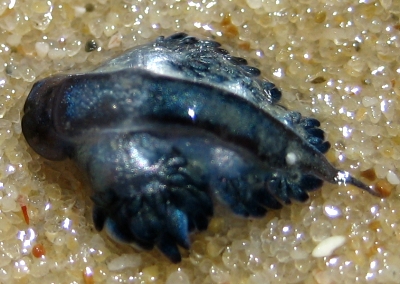
Hello,
I'm sending an image with this letter, hoping you can identify this interesting organism that I saw on a recent trip to Australia.
It was found along Alexandria Beach at Noosa National Park, in Eastern Australia. The size is about 5 cm diameter. A marine biologist in the states suggested a shell-less mollusk, but we were uncertain. As I've only ever seen one nudibranch in real life, I'm quite unclear as to which one of these is might be (or if it's even something else!).
Locality: Alexandria Beach, Noosa, on wet sandy beach, Queensland, Australia, Pacific Ocean, 23 March 2006, intertidal, clean sand. Length: 5 mm. Photographer: Mary Patterson.
This is a wonderful website; quite a resource! Thanks for any help you can give identifying this mystery (to me) organism!
Sincerely,
Mary Patterson
maryjpatterson@yahoo.com
Patterson, M., 2006 (Apr 26) Not sure if this IS a sea slug?. [Message in] Sea Slug Forum. Australian Museum, Sydney. Available from http://www.seaslugforum.net/find/16367Dear Mary,
It looks quite sad lying there looking a bit like a bedraggled dead bird. It is indeed a nudibranch, and its name is Glaucus atlanticus. Have a look at the species Fact Sheet and the related messages at the bottom of the page for information on this spectacular - when alive - animal.
I hope you enjoyed your visit to Australia
Best wishes,
Bill Rudman
Glaucus at Anna Bay, New South Wales
March 31, 2006
From: Jim Doyle
Washed up on the northern end of Stockton Beach, Birubi Point, were a number of Glaucus along with blue bottles and other blue creatures. They differed from the photographs that I have seen in that they were extremely "fat". So much so that their bodies were larger than their appendages.
This was before they "blew" themselves up.
A couple of people reported being stung by them.
Locality: Anna Bay , Beach, N.S.W, Australia, Pacific Ocean, 26 March 2006, Surf line (tide line). Length: 1 - 3 cm
Jim Doyle
doylejim@bmr.net.au
Doyle, J., 2006 (Mar 31) Glaucus at Anna Bay, New South Wales. [Message in] Sea Slug Forum. Australian Museum, Sydney. Available from http://www.seaslugforum.net/find/16206Dear Jim,
The cyclone (hurricane) that has just worked its way down the Tasman Sea just off the east cost of Australia has certainly created the conditions which wash Glaucus and the 'blue fleet' ashore. Glaucus often becomes fat and inflated, as you describe, when washed up on the sand. I think it's to do with the design of their body. The only thing that keeps them 'in shape' is the fluid in their body cavity - what we call a 'hydrostatic skeleton'. Their cerata are quite sensitive to touch and so when they wash up on the sand their cerata are subjected to an overload of touch sensations and so contract as much as they can in an attempt to get away from the sensations. This contraction forces the fluid out of all the cerata into the body cavity where there is nowhere else for it to go - so the body wall stretches - and they become balloon-shaped. Not a happy end.
Best wishes,
Bill Rudman
Re: Cannibalism in Glaucus?
March 30, 2006
From: Peter Whiter
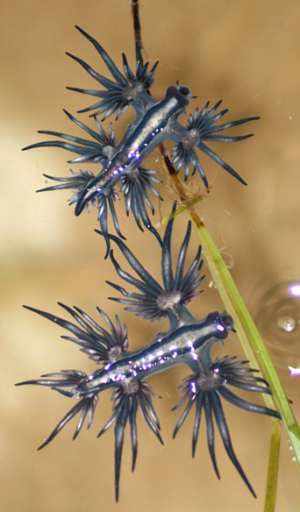
Concerning message #16189:
As it gets close to 48hrs, I feel the need to give an update on the Glaucus atlanticus in captivity at Eden.
Firstly - interesting news, Since looking further into the Forum Anna is now sure that the first little one was infact a Glaucilla marginata (sorry for the mislead, and yes Bill if you so desire, fix my first post).
As noted before the largest one ate the smallest one, leaving 3, the next smallest (22 mm) eventually died, I would say as Bill noted due to the Surf prior to standing and being stranded for who knows how long. Yesterday a trip to the beach got a few Physalia and the remaining two have been tucking into one (each) of these this morning. Anna is looking after them and I'm trying not to interfere. We both thing maybe a water change (30 - 50 %) today or tomorrow.
Locality: Pambula Beach FSC, NSW, Australia, 27 March 2006, stranded on beach not quite storm seas .....but close. Length: 15, 22, 29, 35 mm. Photographer: Peter Whiter
But at this stage they look fine (well as fine as we think they are fine, movement and they are SURE attached to the Physalia )
We were a little concerned about the Physalia being dead in the tank so after they left them alone and not being able to see just how much they have eaten of the Physalia we removed 2 of the 4 Physalia out of the tank. later the Glaucus were found attached mouth-to-mouth with both Penis out, who knows about damage but were sort of easy to seperate (tho it was IMPOSSIBLE to separate the large one from the Glaucilla). Some hours later Anna being worried about how much they had (not) eaten and the fact that they could eat each other, decided to give them a piece of her Goldfish food (yes I freaked at this news too). One of the Glaucus was very receptive caught the food in its parapodia and worked its self to get the food to its mouth (yay) in a rather aggresive manner. The other not so aggresive in its manouvers and when it got the food to its mouth it didn't seem to eat it (guess we need to try a dif brand) and went back to standard "glaucuring".
Time will tell
Pete
peter.whiter@gmail.com
Whiter P.A., 2006 (Mar 30) Re: Cannibalism in Glaucus?. [Message in] Sea Slug Forum. Australian Museum, Sydney. Available from http://www.seaslugforum.net/find/16195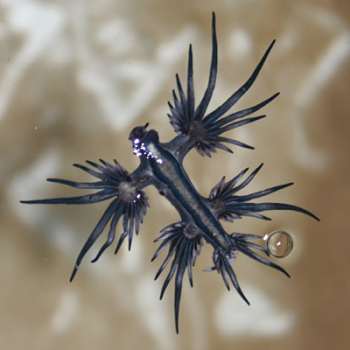
Dear Pete,
Thanks for keeping up to date on your glaucids. If they start eating goldfish food you could be on to a winner but I would be very surprised if they do. They are amazing animals, perfectly adapted for living their lives floating in the open sea. I guess you will have found the photos of their egg strings. Since there are no hard surfaces around to lay a normal egg ribbon on they produce these short straight egg strings which can float around until the larvae hatch out.
Best wishes,
Bill Rudman
Cannibalism in Glaucus?
March 28, 2006
From: Peter Whiter
Hi Bill,
I've been at your site for a few years its great. The main reason for visiting your site tonight was to research the Glaucus, my now Girlfriend (an Artist) has seen them before on the beach and has tried to keep one in captivity (tank, maybe bucket) without much success (it lived only a day or so). today we have the left over of recent Cyclone Waves arrive here (Eden far south coast of NSW) and she found 4 on her walk ... one small about 15 mm in length one about 22 mm (very damaged), then one at about 29 mm, one at 35. After getting them home and into a tank with aeration which seemed to perk them up a bit, a strange thing happened - the largest one attacked and killed the smallest one. The next smallest one (22 mm) may now be dead as he was not doing so well this afternoon.
I guess we have a couple of questions.
1. Do they keep in captvity and how do we prolong this if it is at all possible?
2. have you ever heard of cannibalism in them?
Hope these are a fair questions to ask.
Regards
Pete
peter.whiter@gmail.com
Whiter, P., 2006 (Mar 28) Cannibalism in Glaucus?. [Message in] Sea Slug Forum. Australian Museum, Sydney. Available from http://www.seaslugforum.net/find/16189Dear Peter,
Thes are perfectly fair questions to ask. Firstly until a message last week [see #16154] I had not heard of cannibalism in Glaucus before, but Eve's photos and your observations seem to suggest that at least in close quarters their tolerance for each other is not great.
Concerning keeping them in captivity. I have tried a few times but have never managed to keep them more than 48 hours. It may be better if you start with animals collected in the open sea, but like you I have always started with animals stranded on the shore and I guess by then they have been battered by waves and left out of water on the sand for varying amounts of time. Now I think of it, my best success has been with one or two animals only, so maybe aggressive inter-relationships in tank conditions are a factor worth considering. Perhaps you are better trying to keep a single animal.
Best wishes,
Bill Rudman
What the ?
March 23, 2006
From: Eve Whicker
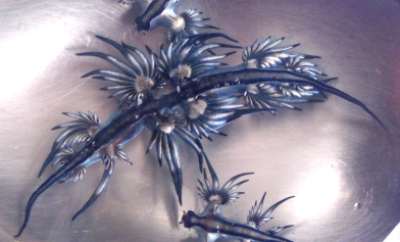
Hi -
I am very curious about Blue Sea Slug [Glaucus atlanticus] behaviour - - - last weekend we had a huge wash up of Blue Bottle and Slugs on my home beach at New Brighton, just north of Byron Bay. We brought several specimens home to take some photos. Over the course of the afternoon I put them in a container together to get some pix of them en masse and the two largest joined up, rolled over, stayed that way for about 5 minutes then separated with a thingy (?) coming out of their sides. One turned over immediately, the other took a minute or two. I can't imagine that they have a need for male combat but then again who knows ? does any one have a clue ?
Locality: New Brighton Beach, nthn New South Wales, Australia, 18 March 2006. Length: largest 4 cm. Photographer: Eve Whicker.
Eve Whicker
eveii@bigpond.com
Whicker, E., 2006 (Mar 23) What the ? . [Message in] Sea Slug Forum. Australian Museum, Sydney. Available from http://www.seaslugforum.net/find/16154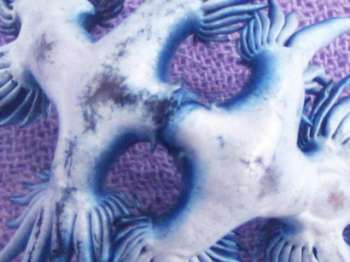
Dear Eve,
I don't think this is related to sex, I suspect its related to close proximity in a bottle. Although Glaucus usually feeds on Bluebottles it is related to other glaucid aeolids which are quite feisty and are known to attack and eat their own kind. Have a look at the photos of Phidiana hiltoni {message #2716] fighting. Another name for this species, Phidiana pugnax, was given to it because of its pugnacious behaviour. So what I think your two animals are doing is biting each other. I don't know if this is normal behaviour because we don't know much about their normal behaviour. So far no student has been silly enough to float around with Blue bottles and Glaucus to record their behaviour.
Have a look at an earlier message [8233] for a photo of the penis. If that is what you saw, then it is also related to close proximity. Animals which float around in the sea most of the time are probably adapted to mating quite quickly when they 'make contact' with another of their kind. Your lower photo shows the brilliant silvery colour on the back of Glaucus. However as these animals spend their time floating upside down the silvery colour will be on the functional underside of the animal. If you compare this with pelagic fish, such as tuna, you will see a remarkably similar colour pattern - silver below, dark blue above. This is called 'countershading' and helps to render the animals invisble from predators below in the water and above in the sky.
Best wishes,
Bill Rudman
What is Filurus dubius?
February 24, 2006
From: Gary Rosenberg
Dear Bill,
I recently came across the name Filurus dubius De Kay, 1843 and am trying to figure out how to list it in Malacolog. Filurus is treated as a synonym of Glaucus at http://www.seaslug.com/systemat.html and in American Seashells (Abbott 1974) it is treated as a possible synonym of Melibe (Chioraera). The original description (DeKay, 1843 -Zoology of New York, 5: 11) says the following:
Genus Filurus.
Tentacula two. Gills in two series along the back. Vent terminal. Caudal appendage long and filiform.
Filurus dubius.
Description. Body cylindrical, enveloped in a loose transparent membrane through which the intestinal tube is apparent. Along the back are two rows of branchial? processes, six in number on each side; at their tips, furnished with five or six spiculae: these are only seen when the animal is in motion. Mouth terminal, composed of a loose festooned membrane, alternately dilating and contracting when the animal is in motion; when dilated, two small transparent tentacula are protruded. The abdomen, or upper surface, appears to be composed of numerous rings. The caudal portion becomes abruptly smaller than the body, is long, cylindrical, and tapering to a point.
Color. Abdomen silvery white; dorsal region and sides light brown; tail light greenish. The color of the body, however, appears to depend on the contained viscera.
Length of body, 0.5; of tail, 0.7 [inches].
This curious animal was taken while swimming in salt water with its body reversed. Its motion was vermicular, and it appeared to be very tenacious of life, as it lived several days in a vessel containing salt water which had not been renewed.
De Kay did not provide an illustration or state where the specimen was collected, but presumably it is from Long Island Sound, New York.
I'd appreciate any thoughts on this creatures identity.
Best wishes,
Gary Rosenberg
Department of Malacology
Academy of Natural Sciences, Philadelphia, USA
rosenberg@acnatsci.org
Rosenberg, G., 2006 (Feb 24) What is Filurus dubius?. [Message in] Sea Slug Forum. Australian Museum, Sydney. Available from http://www.seaslugforum.net/find/15932Hi Gary,
I might as well start the day with a puzzle. I dont think this is a gastropod at all. The mention of a terminal vent [anus] immediately cancels out opisthobranchs and I presume other gastropods. If I saw this description without knowing it had been claimed as a mollusc I would have little doubt in thinking it was a polychaete. His mention of 5 or 6 spiculae which protrude from the tips of the gills when moving is to me a clear description of polychaete parapodia. Which fits with a terminal anus, seeing viscera through body wall, 'vermicular' movement, abdomen consisting of rings, etc.
One possibility is a species of Tomopteris, a planktonic genus of polychaetes some of which have a long filiform 'tail' - although they tend to have more than 6 pairs of parapodia. Another possibility is a species of Syllid worm, several of which are planktonic.
It doesn't fit Glaucus or Glaucilla which have two lobes on each side bearing cerata - no spicules and a lateral anus, and it doesn't fit any Melibe I know. Apart from shape, neither Melibe nor the related Mediterranean Tethys have been reported from the west Atlantic - they swim by lateral flexion of the body, have no spicules etc.
My suggestion would be to flick this name to the Polychaete people. I am sure it is not an opisthobranch.
Best wishes,
Bill Rudman
Glaucus atlanticus - habitat
February 21, 2006
From: Brandon Pinkney
I have been googling the Glaucus atlanticus for some time now but haven't been able to find its habitat It would be uber helpful if you know where it lives pleeeeeaaaaaassssse heeeeelllllllp!?!?!?!?!?!?!?!
Brandon Pinkney
blackessque_13_boi@yahoo.com
Pinkney B.J, 2006 (Feb 21) Glaucus atlanticus - habitat. [Message in] Sea Slug Forum. Australian Museum, Sydney. Available from http://www.seaslugforum.net/find/15892Dear Brandon,
Sometimes you have to stop googling and start reading what you have found. The Fact Sheet on Glaucus atlanticus has all the information you need. I could answer your question directly but I don't think that is what your teacher had in mind.
Best wishes,
Bill Rudman
Is this a sea slug ??
February 14, 2006
From: Karen Beal
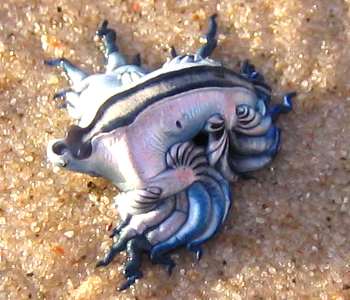
My daughter took this photo of what we may think is a sea slug - but we are not quite sure really what it is. I wonder if you might be able to identify what it is as we are intrigued. It has such beautiful colours & markings.
She found it just a few feet from the sea & there seems to be a baby one just next to it (that has maybe just been born)?..... She said it was about the size of an english penny.
Locality: Byron Bay, nthn New South Wales, Australia. March 2005, a foot away from the waters edge. Photographer: Angela Beal.
Hoping that you can help.
Karen
kybkaren@aol.com
Beal, K., 2006 (Feb 14) Is this a sea slug ??. [Message in] Sea Slug Forum. Australian Museum, Sydney. Available from http://www.seaslugforum.net/find/15798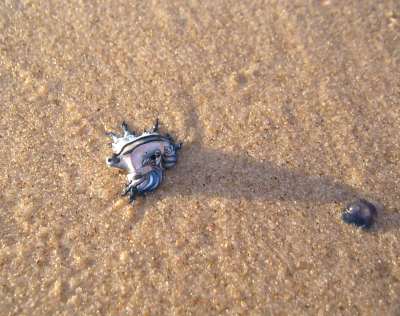
Dear Karen,
This is indeed a sea slug, but it looks a sorry sight when washed up on the beach. It is Glaucus atlanticus, an animal that spends its whole life floating upside down on the water surface, feeding on a fleet of blue animals includingPhysalia (the Portugese man-o-war or Bluebottle). The 'baby' in the right of your daughter's photo is on of these other animals, but I am not sure which one. If you go to the relevant Fact Sheets by clicking on the underlined names you will find quite a bit of information on these fascinating animals. Don't forget to look at the 'related messages' attached at the bottom of each Fact Sheet as they contain a lot more discussion and photos. And to advertise a new feature of the Forum:- If you go to the bottom of each list of related messages you will find a button that allows you to open all the messages at once.
Best wishes,
Bill Rudman
Blue Sea slug
February 2, 2006
From: Liliana Alaniz
I am currently going to middle school and am doing a project on molluska i picked Glaucus atlanticus for an example and need more info. hope you can help.
Sincerely,
Liliana
Lilichis93sd@aol.com
Alaniz, L., 2006 (Feb 2) Blue Sea slug. [Message in] Sea Slug Forum. Australian Museum, Sydney. Available from http://www.seaslugforum.net/find/15734Dear Liliana,
If you are looking for things on the Forum use the Forum search box on the top left of each page. If you go to theGlaucus atlanticus Fact Sheet I am sure you will find enough information for your project. Check out the related messages attached at the bottom of the Fact Sheet as there is a lot more information there as well.
Good luck with your project
Best wishes,
Bill Rudman
Glaucus atlanticus from the Canary Islands
May 23, 2005
From: Kim Boettcher
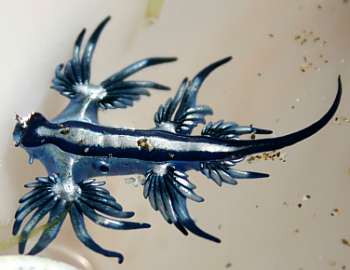
These washed up on Playa Las Vistas beach in Los Christianos, Tenerife, Canary Islands. On the shore they looked like shiny blue "blobs". My son put them in water and they opened up. Any help identifying them would be greatly appreciated.
Locality: Playa Las Vistas, Los Christianos, Tenerife, Canary Islands, Atlantic. washed up on shore. Length: 2 cms.19 May 2005. Photo: Kim Boettcher
Regards,
Kim Boettcher
canadakim@t-online.de
Boettcher, K, 2005 (May 23) Glaucus atlanticus from the Canary Islands. [Message in] Sea Slug Forum. Australian Museum, Sydney. Available from http://www.seaslugforum.net/find/13848Dear Kim,
This Glaucus atlanticus. Have a look at the species Fact Sheet for information on this fascinating sea slug which specnds its life floating upside down in the open ocean
Best wishes,
Bill Rudman
Information on Glaucus atlanticus
April 22, 2005
From: Kealy Baker-Clark
My name is Kealy and I am 9 years old. I am doing an assignment on the glaucus.I can't find information on whether this species is dangerous and why it is considered dangerous or if it is plentiful,rare or endangered. If you could help me with this information that would be good.
P.S. I am looking forward to getting an "A" for my work
Thank you,
Kealy Baker-Clark
dcla6425@bigpond.net.au
Baker-Clark, K., 2005 (Apr 22) Information on Glaucus atlanticus. [Message in] Sea Slug Forum. Australian Museum, Sydney. Available from http://www.seaslugforum.net/find/13591Dear Kealy,
I hope you get an A in your project too! But it's very important that it's for your work not mine. So it's better that I tell you how to find the information you need rather than just give it to you.
In the Forum there is a Fact Sheet for each species, usually with some background information, and then linked to each Fact Sheet are all the messages which have been sent to the Forum about that species. There are also Fact Sheets on more general topics.
If you go to the Glaucus atlanticus Fact Sheet you will see a list of relevant nessages listed below. Look through these and my replies, and you will find plenty of inormation. Some if the questions are almost exactly the same as yours.
Best wishes,
Bill Rudman
Blue, lizard-like feather-finned tiny animal
April 14, 2005
From: Paiton Meurer
On the beach today in Highland Beach, Florida, we found on the shore a bright blue and silvery-white lizard-like animal. It was breathing and moving so we picked it up. We put it in some sea water, and it "opened up" and had fin-like-wings that were feathery and finger-like. It has a tail and a nose and mouth, inch long, some are very small, others are more healthy. They float on the top of the water and swim near eachother. Sometimes they roll up in little balls and flip around. It looked like it was eating parts of seaweed seeds.
Locality: Highland Beach, Florida, USA, Atlantic Ocean. Depth: Shoreline. Length: about 1 inch. 24 March 2005. By seaweed and shells on shoreline washed up.
Please tell me what this species is
Thanks.
Paiton Meurer
cthue22@aol.com
Meurer, P., 2005 (Apr 14) Blue, lizard-like feather-finned tiny animal. [Message in] Sea Slug Forum. Australian Museum, Sydney. Available from http://www.seaslugforum.net/find/13425Dear Paiton,
Without a photo it is a bit difficult to say something sensible, but from your description my first guess would be Glaucus atlanticus. Have a look at the Fact Sheet. If I am right, this fascinating slug feeds on Physalia, the Portugese man-o-war.
Best wishes,
Bill Rudman
Glaucus atlanticus from Reunion Island
February 19, 2005
From: Philibert Bidgrain
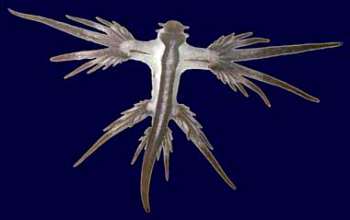
Dear Bill,
Reunion Island sea slugs.
We have only one record of Glaucus atlanticus from Reunion Island.It was observed by Maurice Jay, floating on the surface of the ocean. A few years ago... Photo: Maurice Jay
Best Regards
Philibert Bidgrain
http://vieoceane.free.fr/runseaslug/indexslug.htm
pbidgrain@yahoo.fr
Bidgrain, P., 2005 (Feb 19) Glaucus atlanticus from Reunion Island. [Message in] Sea Slug Forum. Australian Museum, Sydney. Available from http://www.seaslugforum.net/find/13096Thanks Philibert,
Best wishes,
Bill Rudman
Found some interesting sea slugs in Florida
January 31, 2005
From: Sarah McDowell
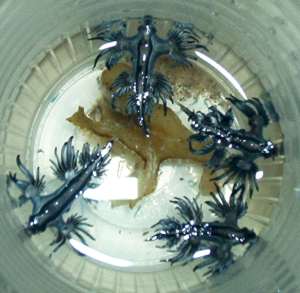
Hi, this pat weekend, my roommate and I were in Pompano Beach, Florida, and she collected these sea slugs off the beach. Apparently the tide had washed them up, and she thought they would die there on the sand. Can anyone tell me what species these little guys are? They're really interesting looking, and I've never seen anything like them on the beach before. Thanks!
Locality: Pompano Beach, Florida, USA.
Length: >1 inch. 29 January 2005. Sand
Photographer: Sarah McDowell
Sarah McDowell
smcdowell5@bellsouth.net
McDowell, S., 2005 (Jan 31) Found some interesting sea slugs in Florida. [Message in] Sea Slug Forum. Australian Museum, Sydney. Available from http://www.seaslugforum.net/find/13068Dear Sarah,
The blue ones are Glaucus atlanticus, which spend their life floating on the surface of the ocean until washed ashore by onshore winds. Have a look at the species Fact Sheet for interesting information about this species and its close relative Glaucilla marginata. The brown object in the bottom of your container is either a bit of brown algae or the very cryptic nudibranch, Scyllaea pelagica, which as its name suggests, is also a pelagic species. In this case rather than floating in the water, its lives on floating Sargassum weed, which also gets blown ashore. Again, have a look at the species Fact Sheet and the other messages on the Forum concerning this species
Best wishes,
Bill Rudman
Neon Blue sea slug from Fraser Island?
January 1, 2005
From: Neil Rhodes
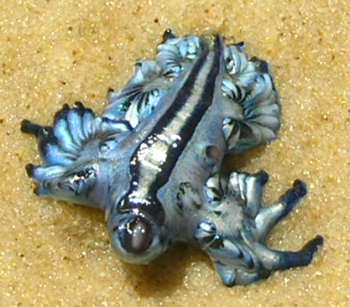
This was found washed up on the beach on Fraser Island and photographed on the spot, it was not touched as the person taking the photo was unsure what it was. Described as being the size of a UK 50 pence coin.
Locality: Beach, washed up on sandy beach, Fraser Island, Queensland, Australia, Length: 12 mm. 12 November 2004. Photographer: Ginny Marsh
Vivid neon blue in colour with black tips to its feather appearance. Please help if you can, it may not even be a sea slug but heaving trawled through this forum it seemed to me that if anyone can identify this mystery its you guys.
Please help.
Many thanks and in anticipation
Neil
neil@digital-cameras.com
Rhodes, N, 2005 (Jan 1) Neon Blue sea slug from Fraser Island?. [Message in] Sea Slug Forum. Australian Museum, Sydney. Available from http://www.seaslugforum.net/find/12868Dear Neil,
Sea slugs don't look their best when they are stranded like this out of water. This is Glaucus atlanticus which you will see on if you have a look at the Fact Sheet, and accompanying messages, is a remarkable nudibranch which spends its life floating upside down on the water surface, feeding on Physalia, which in Australia we call a 'blue-bottle'. It is certainly worthwhile treating this animal with care because when it eats a blue-bottle it stores the worst of the stinging cells in the tips of the blue-tipped processes [cerata] arranged in fan-shapes down its body, and reuses them for its own protection
Best wishes,
Bill Rudman
Is this a nudibranch?
January 21, 2004
From: Scott Godwin
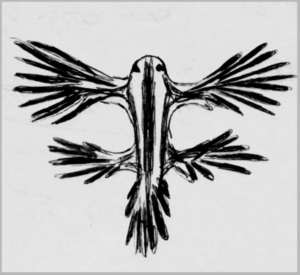
My girlfriend and I found a small animal washed up on a beach about 40 km north of Port Macquarie, New South Wales [Australia]. It was about 4 - 5 cm in length, with a soft, muscular body like that of a gastropod but without the characteristic foot.
It had four 'arms' extending from its sides. The two anterior arms were longer than the posterior ones, and all four ended in a number of feathery appendages that looked to me like gills. There were more of these appendages extending posteriorly from the tail. The animal had two clearly visible eyes. It was a pale creamy white on the ventral surface and had very dark bluish black stripes running along the length of its dorsal surface and extending out along the 'arms'. I have included a sketch of the animal viewed from the dorsal side.
Scott Godwin
sgodwin@metz.une.edu.au
Godwin, S., 2004 (Jan 21) Is this a nudibranch?. [Message in] Sea Slug Forum. Australian Museum, Sydney. Available from http://www.seaslugforum.net/find/11949Dear Scott,
Thanks for the sketch. I think I could have identified this from your good description. It is a very strange aeolid nudibranch called Glaucus atlanticus which spends its life floating upside down in the open ocean feeding on Blue bottles and related cnidarians. Have a look at the species Fact Sheet for more information.
As Juleen's message from South Africa illustrates, this species is found in warm and temperate waters throughout the world. Be careful if you pick this animal up, because it stores the stinging cells of the blue bottle at the tips of the appendages [cerata] on each side of its body
Best wishes
Bill Rudman
Glaucus atlanticus from Sth Africa
January 21, 2004
From: Juleen du Toit
In January of 1998, my son and I found some little white blobs on the Muizenberg beach on the False Bay coastline of South Africa after a gale force southeasterly wind for about 2 days on the fringe of the waterline amongst loads of blue bottles.
Curious as to what it is, we inspected some by submerging them in sea water and discovered the most beautiful royal blue 'things' which was identified by the Two Oceans Aquarium on the Victoria and Albert Waterfront in Cape Town, South Africa as the nudibranch Glaucus atlanticus. It was quite a surprise to see on this site how far these delicate creatures are spread over the world! (Maybe one can't call them 'delicate' since they EAT blue bottles?? They sure like their food 'hot'!)
Since finding it the first time, I have found it during the summer months (now that you ID them as 'tropical' that makes sense) but unfortunately by the time it is washed out on the beach, it is dead. The Indian Ocean is the warmer side of the ocean surrounding the Cape Peninsula. The pictures are stunning and I am totally fascinated by these colourful beings. Thank you for such a load of information. My attempts at pictures feel rather feeble looking at these beauties.
Juleen du Toit
juleen@ananzi.co.za
du Toit, J., 2004 (Jan 21) Glaucus atlanticus from Sth Africa. [Message in] Sea Slug Forum. Australian Museum, Sydney. Available from http://www.seaslugforum.net/find/11959Dear Juleen,
By coincidence I have another message about this fascinating animal to post today. But its from eastern Australia - an ocean away
Best wishes
Bill Rudman
Glaucus atlanticus from Queensland
December 3, 2003
From: Nick Falconer
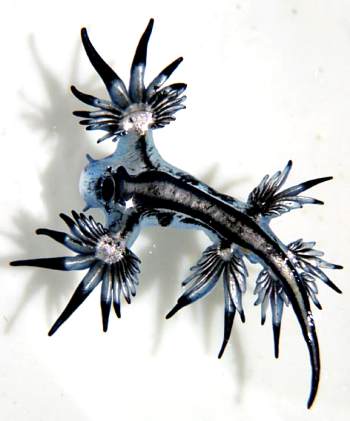
Dear Bill,
Fantastic site and it just about answered nearly all the q's my kids had for me about the creature in the attached pics. There were probably about 10 - 20 of them varying in size on the high tide mark at Alexandra Headland [Sunshine Coast, Queensland, Australia] on Saturday. From your site info I gather they feed on the tentacles? of blue bottles but there were not a large number of bluebottles on the beach that day but they preceded a large blue bottle and big saturation of our beaches on Sunday of the (not sure of the scientific term) tri(something) weed. I'm sure you know the name. Where the beaches on the Coast becomes saturated in what looks like a polluted water/brown mass which is just the weed that comes off the reefs and settles on the beach.
Not sure if that has any relevance on my sighting of the nudibranch. It is however the first time in 25 years of living surfing/observing our beaches that I have seen them. One question I have is about the mushroom type brown attachment on its left side in my photo ..... is that a sexual organ / an effluent outlet? Sorry for all the questions but my kids are interested and want to present it at school and I am a photographer/journalist and wish to write a short article for our newspaper here.
Thanks in anticipation of your help.. fascinating creatures .. I released the little guy after photographing him at home.
Regards,
Nick Falconer
nfalconer@powerup.com.au
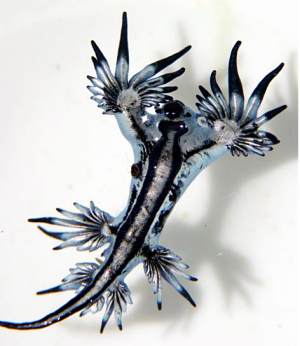
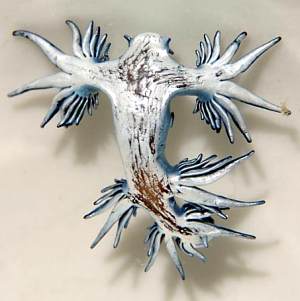
Dear Nick,
The brown 'weed' you mentioned is made up of masses of the microscopic blue-green algae Trichodesmium. Blue bottles and Glaucus and all the other organisms that float with them in the open sea are essentially at the mercy of the currents and winds so when there are onshore winds for a few days they tend to be stranded on the shore. Often the Glaucus arrive a day or so earlier than the blue bottles because they are more easily blown along by the wind. Glaucus eat all parts of the blue bottle, although I must admit I have never seen them eating the float. The brown-black object on the left side in your upper tight and lower left photos is the reproductive opening. As the animal spends its life floating upside down this is really the animal's right side. In earlier messages there are photos of the penis [message 1] and the egg strings [message 2]
Best wishes
Bill Rudman
Glaucus from Wellington Pt, Brisbane
November 17, 2003
From: Mimi & Phong
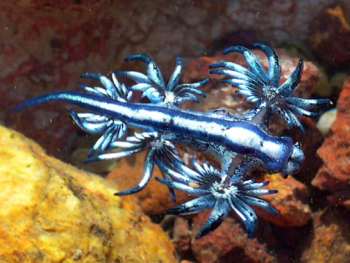
Hello,
We came across this during a walk around Wellington Point, Brisbane [Queensland, Australia] and it looks rather cool, however we have no idea what it is, perhaps you could help?
Mimi & Phong
mythuynguyenle@hotmail.com
Mimi & Phong, 2003 (Nov 17) Glaucus from Wellington Pt, Brisbane. [Message in] Sea Slug Forum. Australian Museum, Sydney. Available from http://www.seaslugforum.net/find/11427Dear Mimi & Phong,
This is a nudibranch which is usually found floating in the open sea. It is sometimes washed inshore where it get stranded on beaches or in tide pools. Have a look at the Fact Sheet for Glaucus atlanticus for further information
Best wishes
Bill Rudman
Glaucus in Hawaii
May 27, 2003
From: Chaunte Ling
Hi,
My brother found a sea slug at one of the beaches by my house. We live in Honolulu, Hawaii and this was the first time we saw something like it. I came home from boston and my brother and my dad had this weird looking thing in my fish tank. None of us knew what this little thing was. I stayed up late last night looking on the internet to figure what this thing was. At first I looked up jellyfishes, because when I was watching it is was kind of moving it's tenticles like a jellyfish. After awhile a blue sea slug website came up. This creature is very interesting and I was wondering if this sea slug is rare in Hawaii. I got to catch some man-of-wars to feed it and it was cool to watch it eat. If I were to catch some man-of-wars and put it in a jar would they be able to last or how long would they last? How do you tell if a sea slug is male or female? and How do you know if it is pregnant?
Thank you very much.
Chaunte
tay999@hotmail.com
Ling, C., 2003 (May 27) Glaucus in Hawaii. [Message in] Sea Slug Forum. Australian Museum, Sydney. Available from http://www.seaslugforum.net/find/10028Dear Chaunte,
If you go to the Glaucus atlanticus Fact Sheet you will find quite a bit of information on this animal and its close relative G. marginata. Also scroll down on each page to see all the other messages about this topic.
Glaucus lives in the oceanic waters and is only found on shores when the wind blows it aground. Whenever you have Portugese man-of-wars [Physalia] washing ashore you are likely to find Glaucus. Concerning your other questions. All sea slugs are hermaphrodite - that is they have functional male and female reproductive systems. They also lay eggs so we can't really say they become pregnant. Have a look at the photos of the floating egg strings they produce.
Best wishes,
Bill Rudman
Mysterious blue and white swirley things
April 25, 2003
From: Sally
Hi kind sea slug experts
Today at Patchs Beach just south of Ballina [northern New South Wales, Australia] we discovered some creatures that sadly we did not photograph but to make life difficult for you we would love some information about them just based on our word of mouth. (trust us). These stunning creatures were approximately the size of a 20 cent piece, white and blue swirls with a head that resembled a seal and 4 webbed legs. Although we have visited many Sydney beaches quite frequently we have never met such interesting gorgeous creatures before and would love to know what they were so we could research them more fully
In true appreciation
Sally and Al.
ssally6@yahoo.com.au
Dear Sally & Al,
From your description, I would make a wild guess that you have found Glaucus atlanticus or Glaucilla marginata - or perhaps both. Have a look at the Fact Sheets for both those species by clicking on the underlined names for further information. Also have a look at the other messages about these species by scrolling down each page. If my guess is wrong then give me a few more clues
Cheers
Bill Rudman
Re: Glaucus in Sydney
March 19, 2003
From: Alex & Marcus Dawes
Dear Bill,
Thanks so much for for your reply
- The website is awesome and full of useful and fascinating information. We are hooked!!
Alex (10) and Marcus (8)
dawes26@tpg.com.au
Dawes, A. & M., 2003 (Mar 19) Re: Glaucus in Sydney. [Message in] Sea Slug Forum. Australian Museum, Sydney. Available from http://www.seaslugforum.net/find/9439Glaucus in Sydney
March 12, 2003
From: Alex and Marcus Dawes
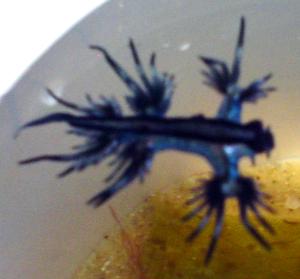
Dear Bill,
We found this 'floating' in shallow water at Clovelly [Sydney, NSW, Australia] beach today .... We think it is a nudibranch of some kind but would be grateful if you can identify it from this (awful) photograph,,,
...It is 3 cm long and has silver and dark blue stripes (white underneath) ... Has 6 feathery limbs ... small head with horns or
antennae .... Looks poisonous!!
Our aunt saw something very similar at Pearl Beach on the Central Coast today .... Maybe it's an invasion?!
Thanks and Regards
Alex (10) & Marcus (8) Dawes
dawes26@tpg.com.au
Dawes, A. & M., 2003 (Mar 12) Glaucus in Sydney. [Message in] Sea Slug Forum. Australian Museum, Sydney. Available from http://www.seaslugforum.net/find/9389Dear Alex and Marcus,
This is indeed a nudibranch called Glaucus atlanticus. If you look at the species Fact Sheet you will see its spends its life floating upside down at the water surface, bouyed up by a bubble of gas in its stomach. It feeds mainly on Blue Bottles [Physalia] and takes the most powerful of their stinging cells [nematocysts] and stores them at the tips of the 'feathery limbs' which are called cerata. You can sometimes get a worse sting from Glaucus than from a Blue Bottle. Have a look at the other messages on this page and the various links to other pages for more information on these fascinating animals.
Glaucus floats around in the ocean with 'fleets' of Blue Bottles. Like Blue Bottles they usually only wash up on beaches after a few days of steady onshore winds which blow them onshore. So its not surprising to find them washing up on a section of the coast between Sydney and the Central Coast when weather conditions have been the same
Best wishes,
Bill Rudman
Glaucus atlanticus from Lord Howe Island
January 24, 2003
From: W.B. Rudman
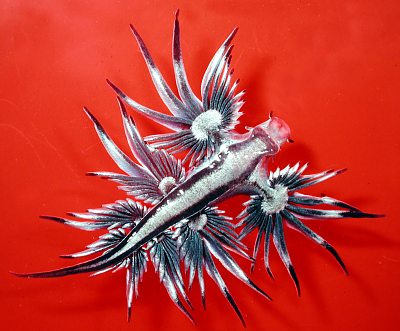
Here is a photo record from Ian Hutton of Glaucus atlanticus from Lord Howe Island.
Location: Lagoon Beach.
Bill Rudman
Rudman, W.B., 2003 (Jan 24) Glaucus atlanticus from Lord Howe Island. [Message in] Sea Slug Forum. Australian Museum, Sydney. Available from http://www.seaslugforum.net/find/8963Glaucus atlanticus reference
November 14, 2002
From: Michael Schroedl
Dear Bill,
Could you help me with the full citation of Forster 1777, for Glaucus atlanticus please? I couldn't find that anywhere...
Thank you very much and all the best, Michael
schroedl@zi.biologie.uni-muenchen.de
Dear Michael,
Since we have a copy here at the Museum I can help you out. I guess today we would consider Forster's 'naming' of this species and genus to be unacceptable. I copy the relevant sentence from his published diary of the voyage:
"Monday 14 [Sept, 1772]
This day we caught several dolphins, and a flying fish one foot long fell on the quarter-deck. ..... We had also at various intervals, found the sea covered with animals belonging to the class of mollusca, one of which, of a blue colour, in shape like a snail, with four arms, divided into many branches, was named glaucus atlanticus; ...... " (Forster, 1777: p. 49).
For a history of the name and its synonyms, Bergh has an extensive review (1884: 10-16) in the Challenger Expedition reports. Unfortunately some of these old works are difficult to cite correctly. Although the work includes 'by George Forster' on the title page it is based upon the journal of Johann Reinhold Forster, who accompanied his brother Georg on the voyage. Authorship however is consistently attributed to Georg. Today we normally include Publisher and Place of Publication. It was published in London and four printers are named: B. White; J.Robson; P. Elmsly; and G. Robinson. In those days books were often privately published.
• Bergh, L.S.R. (1884) Report on the Nudibranchiata dredged by H.M.S. Challenger during the years 1873-1876. Report of the Scientific Results of the Voyage of H.M.S. Challenger during the years 1873-76, ... Zoology, 10(26): 1-154, pls. 1-14. [Glaucus: p.10-16]
• Forster, G. (1777) A voyage round the world in His Britannic Majesty's sloop, Resolution, commanded by Capt. James Cook, during the years 1772, 3, 4, and 5 by George Forster. Vol 1: p49. (White, Robson, Elmsly & Robinson: London)
Best wishes,
Bill Rudman
Glaucus atlanticus - observations
October 21, 2002
From: A. Lovatt.
Dear Dr Bill Rudman,
I saw a number of Glaucus atlanticus, and noticed that after some time, an object protruded from their left side just behind the first pair of "limbs". It had a sharp tip. The longest object I saw while watching, was about 10mm long. Some of the Glaucus atlanticus were as large as 60mm. I also observed that they attempted to propel themselves with some effect. The information that I have seen says (in some cases), that these animals are almost incapable of self propulsion.
Do you know what this object could be? Has there been any studies of how these creatures move?
Thank you
A. Lovatt.
New Zealand
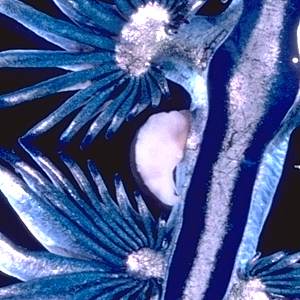
Dear Mr Lovatt,
I suspect the object you saw was its penis. Have a look at the image alongside. The white curved object in the centre is the half everted penis. The tip is at the bottom. It can extend even further than this, and I guess it is proportionally so large because the large ceratal clumps make it difficult for these animals to get very close to each other.
Regarding movement - they can certainly 'wiggle' from side to side, which will give them some movement in the water, but in terms of functional locomotion - that is 'going somewhere' - they are a dead loss, and rely on water movement and wind.
Cheers,
Bill Rudman
Thanks
June 15, 2002
From: Amanda Johnson
Thankyou very much for your help. I got an A on my assignment!
Thanks again.
Manda.
003421@bribislashs.qld.edu.au
Johnson, A., 2002 (Jun 15) Thanks. [Message in] Sea Slug Forum. Australian Museum, Sydney. Available from http://www.seaslugforum.net/find/7261Glaucus atlanticus information
June 6, 2002
From: Manda
Hey
I'm doing a school project on Glaucus, I was wondering if you could tell me some things. I need to know about First Aid if you come into contact with one of these amazing little creatures as I can't seem to find anything anywhere else.
I also need a better idea of where they can be found around Australia.
Thanks heaps for your help
Manda
003421@bribislashs.qld.edu.au
Manda, 2002 (Jun 6) Glaucus atlanticus information. [Message in] Sea Slug Forum. Australian Museum, Sydney. Available from http://www.seaslugforum.net/find/7151Dear Manda,
I guess you have found all the information about Glaucus and Glaucilla on the Forum. Just click on any underlined word to go to another relevant page.
Concerning First Aid. Although these nudibranchs can give you a more powerful sting than the 'Blue Bottles can, you are less likely to be stung by them because they don't have the same long trailing tentacles. The only times I have known of kids being stung badly by Glaucus have been when they have been throwing them at each other and they have hit their backs or other relatively tender parts of their skin. So don't be too worried about them - you are still more likely to be stung by a Blue Bottle. Concerning First Aid, I don't really want to give medical advice. As Glaucus gets its stings from the Blue Bottles, whatever works for Blue Bottle stings is the best treatment. Unfortunately treatments for Blue Bottle stings seem to come in and out of fashion. So you should check with your doctor or perhaps a local Lifesaving Club for advice on Blue Bottle stings and follow that.
Glaucus and Glaucilla can be found all around Australia - where ever Blue Bottles can be found. They usually live out at sea but can be blown inshore with Blue Bottles if there are a number of days of onshore winds.
Good Luck with your project,
Bill Rudman.
Re: Collaroy 'Blue Dragon' - thanks
May 23, 2002
From: Stephen Martin
Bill
Thanks for your timely response and info. Next time we will not pick them up. The kids were absolutely delighted to know that they feed on blue bottles.
Steve
smartin@sl.nsw.gov.au
Martin, S., 2002 (May 23) Re: Collaroy 'Blue Dragon' - thanks. [Message in] Sea Slug Forum. Australian Museum, Sydney. Available from http://www.seaslugforum.net/find/7030Mass of blue dragon(?) nudibranchs
May 20, 2002
From: Stephen Martin
Late last summer at Collaroy swimming pool [Sydney, NSW, Australia] my sons and I found 18 nudibranchs (blue, black and silver). They appeared to be dead as we could pick them from the surface of the pool water. As we put them back over the pool wall they moved so may have been only stunned. (OR simply lethagic). It was a very overcast day, after rain and the tide was nearly full. Unfortunately there are storm water drains near the pool so I guess pollution cannot be ruled out. They may be blue dragons but I cannot confirm this from the reference books.
Any ideas ?
Steve
smartin@sl.nsw.gov.au
Martin, S., 2002 (May 20) Mass of blue dragon(?) nudibranchs. [Message in] Sea Slug Forum. Australian Museum, Sydney. Available from http://www.seaslugforum.net/find/6999Dear Steve,
There are a couple of nudibranchs which have been given the common name 'blue dragon' in eastern Australia. One is the spectacular Pteraeolidia ianthina which I have described as 'solar-powered' because like corals it can store and utilise single-celled plants in its tissues. From your description however I suspect your animal is the other 'blue dragon', Glaucus atlanticus, which floats on the surface of the ocean, drifting with great aggregations of the blue-bottle Physalia on which it feeds. If you have a look at the Fact Sheet on Glaucus you will see that it can store the most powerful stinging cells from the blue-bottle and use them for its own protection when attacked.
Have a look at the other messages on this page as the Forum now has a lot of information on these fascinating animals from many parts of the world.
Best wishes,
Bill Rudman
Questions about Glaucus
April 25, 2002
From: Luke Short
Dear Bill,
I am a lifeguard on the Sunshine Coast and lately we have been experiencing strong onshore winds. With these consistent winds of course, I have noticed many of these organisms being washed onto the beach- more often then not at the same time. Until I discovered this website I had been absolutely puzzled in regard to identifying what these creatures were and I basically knew nothing about them except whether or not they harmful to humans (such as the bluebottle Physalia physalis ). I have noticed that when I pick up a Glaucus or Glaucilla it leaves some blue part of its anatomy on my hand - they appear to be the cerata(?). Do you know why the organism does this? Another question I have regards the Purple Bubble-raft Snail (Janthina janthina ). When I provoked a floating snail, it appeared to emit a bright blue fluid into the water as some kind of defence mechanism. Is it possible for you to shed some light on this matter?
Thankyou for your time and also for such a great website. So many people ask me what these creatures are and up until now I have been substantially clueless!
Thankyou,
Luke.
lukeshort1979@hotmail.com
Short, L., 2002 (Apr 25) Questions about Glaucus. [Message in] Sea Slug Forum. Australian Museum, Sydney. Available from http://www.seaslugforum.net/find/6718Dear Luke,
I have been meaning to put up a page on Bluebottles and Janthina since they are so associated with Glaucus and Glaucilla so your question was a good opportunity.
Firstly on the blue bits that break off Glaucus and Glaucilla. Yes they are cerata. Quite a few nudibranchs break off parts of their bodies as a defensive strategy, a bit like a lizard dropping its tail. Have a look at the Autotomy page. As you've no doubt read, Glaucus and Glaucilla store stinging nematocysts from the Bluebottles in their cnidosacs and firing them is their first line of defence. At times though they will break off a whole ceras.
I haven't seen Janthina spp called 'Purple Bubble-raft Snails' before, but it is an appropriate name. They produce a bubbly mass of mucus - much like a garden snail - which hardens to form a float so they can stay at the water surface where they feed on Bluebottles. The purple ink they produce is produced by a special gland in their mantle called the Hypobranchial Gland. Many marine snails produce such a secretion and one family, the Muricidae, produce a secretion which turns purple or red on exposure to late. Tyrian Purple was a 'red' rather than purple dye, first made in Tyre in the eastern Mediterranean 2-3000 years ago in what was probably one of the earliest chemical industries. The dye was obtained from the hypobranchial gland of muricid snails. It was extremely valuable and in Rome only robes dyed with Tyrian purple were a sign of high office.
This doesn't actually answer your question about its function in Janthina. I'm afraid we have no good idea of the function of the hypobranchial gland and its secretion in any snail. Various functions have been suggested but none have been demonstrated. Another of life's little mysteries.
Best wishes,
Bill Rudman
Blue plankton in Uruguay
February 16, 2002
From: Philip Miller
Recently there was a great arribada of blue plankton in our coast, in SW Atlantic ..... millions of Velella, hundreds of Physalia and Janthina, and less of Glaucus could be seen from Valizas to Santa Teresa .... would like to know about their ecology, specially their reaction to temperature and salinity changes, as well as their predator-prey relationship.
Philip Miller
FCIEN
Soriano 1510
Montevideo, 11200
Uruguay
maritimo@adinet.com.uy
Miller, P., 2002 (Feb 16) Blue plankton in Uruguay. [Message in] Sea Slug Forum. Australian Museum, Sydney. Available from http://www.seaslugforum.net/find/6211Dear Philip,
A recent report on the Forum from Florida suggests that the populations of these fascinating animals are quite high in the western Atlantic at the moment. We have recently had large numbers washing up on the shores of southeastern Australia as well.
You will find a bit about the nudibranch members of Sir Alistair Hardy's Blue Fleet on the Forum but I'm afraid I can't help you much with the others. I suspect there is not much known about their ecology and population dynamics. The molluscan members, including the nudibranchs and the Violet Snails (Janthina spp), are voracious carnivores feeding mainly on Physalia and other cnidarians such as Porpita and Velella. I know that Physalia eats small fish, but both Porpita and Velella have symbiotic zooxanthellae in their tissues which would suggest that at least some of their nutritional requirements would be met by photosynthesis.
Great aggregations and wash-ups of these animals seems to be caused by currents and winds driving them together. Although they occur in large groups, these are usually found in the open oceans.
Best wishes,
Bill Rudman
Glaucus from Pensacola, Florida
February 4, 2002
From: Elvira Davis
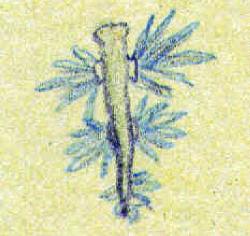
Can you please help me identify this sea creature? It was found washed up on the shore of Pensacola Beach in NW Florida, USA just 2 days ago [30 Jan 2002]. Attached is a pretty pitiful sketch of it -- I'm no artist! It is about 1 inch long and there were many of them washed up on the shore along with many Portuguese man-of-wars. Thank you!
Elvira Davis
Stelda91@cs.com
Davis, E., 2002 (Feb 4) Glaucus from Pensacola, Florida. [Message in] Sea Slug Forum. Australian Museum, Sydney. Available from http://www.seaslugforum.net/find/6171Dear Elvira,
Your 'artwork' is excellent and certainly allows me to identify your find as Glaucus atlanticus. Have a look at the Fact Sheet for more information. This strange nudibranch spends its life floating upside down on the surface feeding on Physalia - the Portuguese man-of-war, which in Australia is commonly called 'the Blue-bottle'. Like most aeolid nudibranchs, Glaucus takes the stinging cells (nematocysts) from Physalia for its own use. It stores them in special sacs (cnidosacs) at the tip of the finger-like processes (cerata) down each side of its body.
Have a look at the other messages on this page for more information on this animal which is found in most oceans of the world.
Best wishes,
Bill Rudman
Re: Glaucus detecting prey
March 18, 2001
From: Belinda Biggam
Dear Bill
Many thanks for your reply re. nudibranchs detecting their prey - your information said pretty much what I have since been able to find out, so it's great to have this confirmed!
I would also like to say what a great find your Sea Slug Forum was for me - with so much junk on the internet it always makes my day to find something interesting, worthwhile and extremely useful.
Best wishes
Belinda Biggam
belindab@thefutureiswild.com
Biggam, B., 2001 (Mar 18) Re: Glaucus detecting prey. [Message in] Sea Slug Forum. Australian Museum, Sydney. Available from http://www.seaslugforum.net/find/3992Glaucus detecting prey
March 15, 2001
From: Belinda Biggam
I am trying to find out how nudibranchs detect their prey. I am particularly interested in how Glaucus sp. detects and hunts down Physalia. I have trawled through numerous text books and searched the web but to no avail. Would you be able to enlighten me. Look forward to hearing from you ASAP - i'm a researcher in natural history tv and have got an urgent deadline to meet!!
Many thanks.
Belinda Biggam
belindab@thefutureiswild.com
Biggam, B., 2001 (Mar 15) Glaucus detecting prey. [Message in] Sea Slug Forum. Australian Museum, Sydney. Available from http://www.seaslugforum.net/find/3891Dear Belinda,
Many nudibranchs appear to use their rhinophores to sense chemicals in the water and so locate potential food. But this only works when the water is relatively still and the predator can move towards the source of the chemical 'smell'
I know of no study on how Glaucus finds its prey. Glaucus and Glaucilla spend their life floating upside down at the water surface, their foot playing little if any role in locomotion. Like Physalia and other siphonophores, the glaucids seem to be at the mercy of the winds and currents. As I have mentioned elsewhere, Sir Alistair Hardy described this assemblage of animals as 'the blue fleet' clustered together by the currents and eddies. I guess Glaucus can move a bit by lateral flexion of their body, but I suspect they find their food by chance encounters.
I'm sorry if my ASAP has not been as soon as your tv deadline desired but I do this on a voluntary basis. Like kids who want immediate answers for late school projects, I sympathise, but can't oblige.
Best wishes,
Bill Rudman
Re: Glaucus
February 20, 2001
From: Lisa
Hi
I just wanted to thank you all ... I have lived On the Eastern suburbs Beaches of Sydney, Australia all of my life. As a child I quite often saw these creatures [Glaucus] on the shore and usually when Bluebottles were around, but never knew what they were. Today while I was at the beach with my 10 year old son, He found one. Of course he wanted to know what it was .... and all I could say was "well I haven't seen one for a while, but I know its not a bluebottle" He was fasinated by it as I was when I was a kid.(about ten minutes later he got stung by a bluebottle as all good Aussie kids do) BUT NOW I CAN TELL HIM WHAT IT WAS and what's more after 25 years of wondering I KNOW !!!
Lisa
l_harper@dingoblue.net.au
Harper, L., 2001 (Feb 20) Re: Glaucus. [Message in] Sea Slug Forum. Australian Museum, Sydney. Available from http://www.seaslugforum.net/find/3833Dear Lisa,
Glad to be of help. The northeasterly winds in Sydney have certainly blown in the 'bluebottles'.
To those of you who don't know what a 'bluebottle' is, it is a very Australian common name for the jellyfish-like Physalia or Portugese man o' war. Have a look at the top of this page and through the other messages on this page for more information on them.
best wishes,
Bill Rudman
Glaucus
August 24, 2000
From: Chris Parks
Fantastic site - Congratulations!
Very interesting section on Glaucus - which is one of my favourite animals! You might be interested to see some of our images of Glaucus. They can be seen at
http://www.imagequest3d.com/catalogue/surfacedrifters/index1.htm.
Regards,
Chris
chris@imagequest3d.com
Parks, C., 2000 (Aug 24) Glaucus. [Message in] Sea Slug Forum. Australian Museum, Sydney. Available from http://www.seaslugforum.net/find/2910Dear Chris,
Thanks for your comments. You have some very beautiful images on your site.
Best wishes,
Bill Rudman.
Information on Glaucus atlanticus
August 12, 1999
From: Angela
I am currently in first year at University and am preparing a talk about the Mollusc - Glaucus atlanticus. Although my talk is based on the Phylum Mollusca I'm using Glaucus as the example. I'm having trouble finding how it would react if it was disturbed. I have found some wonderful pictures and information on this website but would appreciate you're help in finding the answer to my question. I look forward to hearing from you.
Thanks
Angela
ronr@cdc.net.au
Dear Angela,
If you have a look at the pages on Glaucus atlanticus and Glaucilla marginata you will find quite a bit of background information on these two related species. Also look at the messages below yours on this page as there are some further photos and information on feeding there.
To answer your question about what they do when they are disturbed. Glaucus is a very specialised aeolid nudibranch, and like most aeolids, its main defensive weapon is the cnidosac it has in the tip of each of its cerata. These contain undischarged nematocysts (stinging cells) from its cnidarian prey which the aeolid can reuse in its own defense. At the top of this page I have referred to Thompson & Bennett's study that showed that Glaucus selects the most powerful of the nematocysts from the Physalia it feeds on, and from my experience the concentrated 'sting' from a Glaucus can be much worse than that of Physalia.
I hope this answers your question,
Best wishes,
Bill Rudman.
Eggs of Glaucus and Glaucilla
May 16, 1999
From: Bill Rudman
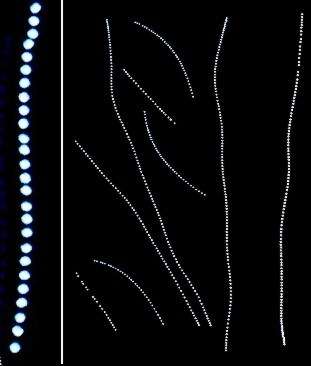
In a reply to one of Ross Armstrong's messages with all the interesting observations on Glaucus atlanticus, I promised to post some pictures of the egg strings of Glaucus and Glaucilla marginata. At last here they are. The long ones are from Glaucus and the short from Glaucilla. Animals such as these which spend their whole life floating at the surface of the water would not be able to attach their egg masses to the bottom or some hard surface like most nudibranchs. Instead they produce a short single strand string of eggs encased in a thin mucus tube (not visible in the photos). These strings float in the water until the larvae hatch. Unfortunately I can't find my notes on the length of the strings.
Bill Rudman.
[Note added 23 June 1999: Here is a relevant paper.
Ross, R.M. & Quetin, L.B. (1990). Mating behaviour and spawning in two neustonic nudibranchs in the family Glaucidae. American Malacological Bulletin, 8(1): 61-66.]
Glaucus & Porpita in New Zealand
March 31, 1999
From: Ross Armstrong
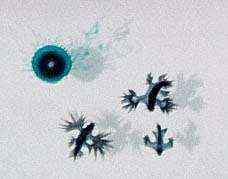
Hi Bill
I sent a copy of your comments off to Bill and Lynda West and they really appreciated the information you provided.
They have also sent me more information about the siphonophore they fed the Glaucus on and would like your thoughts on it:
"The siphonophore was slightly different to what Bill Rudman described. It is a round flattened disc, with a wafer thin but very flexible transparent scale on its top. Around the outer edge is a deep blue coloured mantle, which can be up to 2mm in width in the larger specimens. On the under side of the mantle hang 4-5mm long polyps which look like miniature strings of bluish green beads when put against a white background."
"The underside of the main body of the siphonophore contained a mass of very small blue polyps, not long tentacles as mentioned and the centre polyps were white. This white area was circular, ranging roughly from 0.5mm to 5mm on the large ones. The pattern was the same on every specimen we found."
"Another thing we noted was that when one was placed on bare skin, i.e. the palm of a hand, it would cause the skin to itch in the area that came in contact with the polyps. We wonder if this could have caused the itching
that many swimmers have complained about this summer."
Any ideas on what it is? I have attached a photo they sent to me.
Kind regards
Ross Armstrong
Ross@northpower.co.nz
Armstrong, R., 1999 (Mar 31) Glaucus & Porpita in New Zealand. [Message in] Sea Slug Forum. Australian Museum, Sydney. Available from http://www.seaslugforum.net/find/738Dear Ross,
I'm afraid I didn't do a very good job describing Porpita in my reply to your earlier message. Bill & Lynda's excellent photo is clearly of Porpita pacifica. It has a thin transparent circular disc, as they describe, to which is attached the 'colonial' body. The deep blue part of the animal extends out around the edge when the animal is fully extended in the water. Unlike Velella, Porpita does not have a vertical sail on its disc. Around the edge the tentacles are relatively long and have bead-like structures packed with nematocysts (stinging cells). The white region in the centre is one very modified polyp which acts as the mouth and stomach of the colony. This differs from Physalia which has multiple mouths.
It is possible that Porpita could cause bather's itch, but as it normally lives in association with Physalia and Glaucus, cases of itches which occur when they are not around are likely to be caused by something else. Often bathers itch is caused by one stage in the lifecycle of a parasitic flatworm. These worms have complicated lifecycles with one stage living in snails or bivalves and a second stage living in a vertebrate, often a bird or fish. Sometimes when the larval parasite leaves their snail host and is swimming around looking for the bird or fish it normally infests, they find a swimming human to bore into. They die from their mistake but cause a severe itch in the process.
Please pass on my thanks for the photo and the information.
Best wishes,
Bill Rudman.
Re: Glaucus in New Zealand
February 26, 1999
From: Ross Armstrong
Hi Bill
I read their letter again when I got home and it was me who got the id wrong. They had correctly identified it as Glaucus atlanticus and I had made the mistake in my earlier email. They had also done quite a bit of homework. The first one they found they kept with some Velella to use as food. Unfortunately the Velella died over night as did the Glaucus. They went searching after the next lot of easterlies and found some washed up. First they found some small round jellyfish ranging in size from a pin head to about 10mm across. The closest id they could get was Chondrophore. They found these jellyfish were the preferred food source for the Glaucus they kept. Another comment was that when the feed the Glaucus on a daily basis the mortality rate would climb and concluded that their feeding pattern is on a hit and miss basis.
Here is what they say about them feeding:
"Over the past four days we have watched them feeding. When they come in contact with the food source they wrap themsevles around it sideways and guide the food forward with their fronds (cerata) until they can clasp it with their front fronds. The will either pull the food over their head to eat, or will hang vertically under it while eating. The mouth, which is oval, is located at the front of the head and perhaps is similar to that of a lamprey and the creature will feed voraciously, as though this is this meal is the last it may have for sometime."
Other observations:
"We are unable to detect an anal duct. We think the slight protrusion on the left hand side may house both the anal duct and the reproductive organs as some of the creatures have an opaque white corkscrew like thing protruding from their and yesterday (19 Feb) we noted that two of the creatured seemed to be mating in a back to back position."
"We also noted that when placed in direct sunlight they turn upside down and then back again. Perhaps they are cooling themselves down as their backs are out of the water when they float about. In the sea the wave movement would possibly wash over them thus keeping them cool."
"We also tried using an aquarium pump to keep the water aerated, but this only caused more of them to die. Over-feeding them was also a headache as the death rate started to climb. We think this was due to the toxic nature of the food they ate and figured that they required more time between meals to aid with digestion. We now feed them ever other day."
At one stage they had a total of 38 (the figure of 27 was another mistake I made). Unfortunately a lot had died and they decided to release them:
"The decision has been made to release the survivors as we are unable to locate any more food for them. We took the survivors up to the river mouth and released them into the out going current. What we noticed was that when back in their natural habitat they folded their appendages and fronds back towards their body and stayed just under the surface, whereas in captivity they floated high in the water with their appendages and fronds extended outwards."
Another interesting comment:
"We noted that the waste produced by the Glaucus formed a fine cobweb the occupied the bottom half of the bowl and may be toxic to them. Hence the high death rate when we introduced the air pump."
This may actually be the short egg strings you mentioned.
"We noticed the very small Glaucus (1-2mm long) seemed to disappear overnight when there was a lack of food and also some of the smaller ones starting to loose some of their fronds. We came to the conclusion that Glaucus developed cannibalistic tendencies where there was a food shortage and the larger ones would eat the smaller ones."
Their finishing comment:
"These findings are not based on a scientific study of Glaucus atlanticus but are based on what we noted on a daily basis over the past week."
Personally I think they did an excellent job and I apologise for the inaccuracies of my first e-mail which I wrote without having the letter readily available.
Ross Armstrong
ross@northpower.co.nz
Armstrong, R., 1999 (Feb 26) Re: Glaucus in New Zealand. [Message in] Sea Slug Forum. Australian Museum, Sydney. Available from http://www.seaslugforum.net/find/618Dear Ross,
Thanks for the fuller notes. You are right they have done an excellent job. I wonder whether the small jellyfish is in fact Porpita, the third animal I mentioned. It has a round flattened disc with blue tentacles which stick out all over the bottom of the disc and around the edge. Physalia, Velella and Porpita are all "siphonophores" are group of cnidarians in which each "animal" is better thought of as a colony of polyps, in which the polyps are specialised for particular jobs. In Physalia, for example, one polyps forms the float, others are mouths, others long tentacles, etc.
I wish we could get this sort of information on all nudibranchs.
best wishes,
Bill Rudman.
Glaucus in New Zealand
February 25, 1999
From: Ross Armstrong

Dear Bill
The attached image was supplied by my Uncle and Aunty Bill and Lynda West of Opotiki in New Zealand's Bay of Plenty. (Central east coast of the North Island). In late January they were walking on the beach and encountered some Glaucilla washed up on the shore. At the time neither had seen these before and did not know what it was. They took some samples and had it identified
as Glaucilla alanticus. There have been a lot of easterlies blowing things up on the beach. After getting it identified they went looking for some more. So far they have
found a total of 27. They have tried keeping them in a small aquarium but have a fairly high mortality rate. I believe the photo was taken in the aquarium. Neither are marine biologists but they have made some interesting observations including seeing a pair mating? and also suspecting they might
become cannibalistic if there is a shortage of food. They have been feeding them on jellyfish that have also been washed up. They sent me a letter explaining what they have done and observed but I left it at home.
I look forward to any information you may be able to provide or questions that you may have.
kind regards
Ross Armstrong
Ross@northpower.co.nz
Armstrong, R., 1999 (Feb 25) Glaucus in New Zealand. [Message in] Sea Slug Forum. Australian Museum, Sydney. Available from http://www.seaslugforum.net/find/616Ross,
Thanks for the great photo of Glaucus atlanticus. Whoever identified it for your Aunt & Uncle as Glaucilla atlanticus got it half right and half wrong. There are two very similar looking species, Glaucus atlanticus and Glaucilla marginata. Both have very similar life styles, floating upside down in the sea, feeding on Physalia and other similar floating cnidarians. Have a look at the pages and pictures I have on these two species.
To comment on your observations. Glaucus is usually found washed up on beaches with the Portugese man o' war, Physalia after days of onshore winds. With little power of independent movement they are at the mercy of the winds and currents. They will, like most nudibranchs confined in small containers, mate at the drop of a hat! Being hermaphrodite, every member of the same species is a potential partner. Other animals your Aunt & Uncle could try feeding their Glaucus with are Porpita and Velella, two little blue animals which also float at the surface. One has an oval shaped transparent disc with a diagonally placed "sail" which gives it the name of "By-the-wind Sailor" and the other has a circular disk and no sail.
It is possible that Glaucus and Glaucilla will eat each other, when starving, as other aeolids are known to do that. One other interesting thing about these slugs is that they lay short egg strings of 10-20 eggs which float at the surface until the larvae hatch. I have some photos somewhere. As soon as I find them I will put one on the page for you.
Best wishes,
Bill
